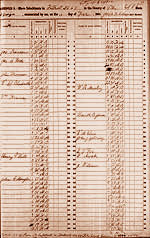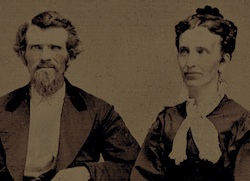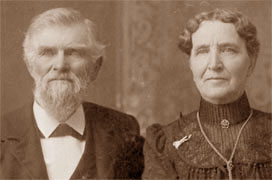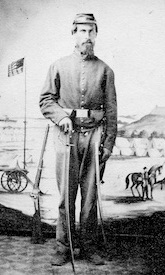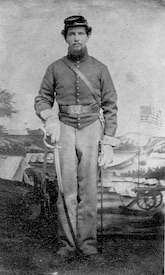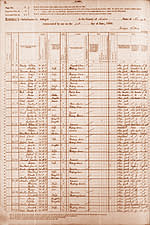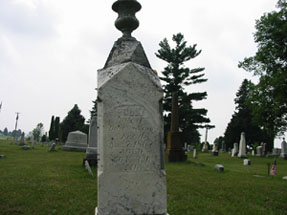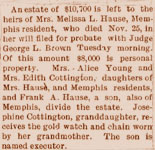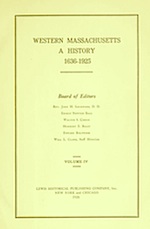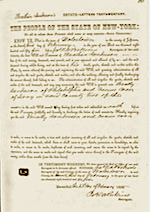
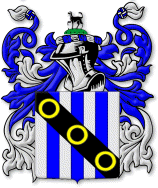 |
| Sanderson |
|
|
The Sanderson family has a proud heritage in Colonial America, as well as in England, where it is one of the oldest surnames on record.
The origin of the surname "Sanderson" is Scottish and English. It's a patronymic from the personal name 'Sander', a reduced form of Alexander, or the classical Greek Alexandros, which probably originally meant ‘repulser of men’, from alexein (‘to repel’) + andros, genitive of aner (‘man’)—which makes it a rotten name for a woman.
The family Coat of Arms features six silver and blue stripes on a diagonal black stripe three gold rings. The Crest is a black dog on a green mound. The family motto, "Je suis veillant à plaire," means "I am watchful to please."
The Sanderson variant of the name is English in origin, and can first be found during the time of the Norman conquests, in the county of Durham. The family there is descended from ALEXANDER de BEDICK, a Norman noble who had been granted lands in Waslington, Durham. His son, James, took the surname SAUNDERSON (from "Alexander's Son").
Here is a Saunderson pedigree from The antiquities of Nottinghamshire by Robert Thoroton (1623-1678). It begins with ALEXANDER de BEDICK (b. @1280) of Blyth, Nottinghamshire, England. He married JANE CANCELLARI (b. @1280) sometime around 1297. Their son, JAMES (or JACOB) SANDERSON de BEDICK was born around 1300 in Blyth. With him, the Sanderson name begins:
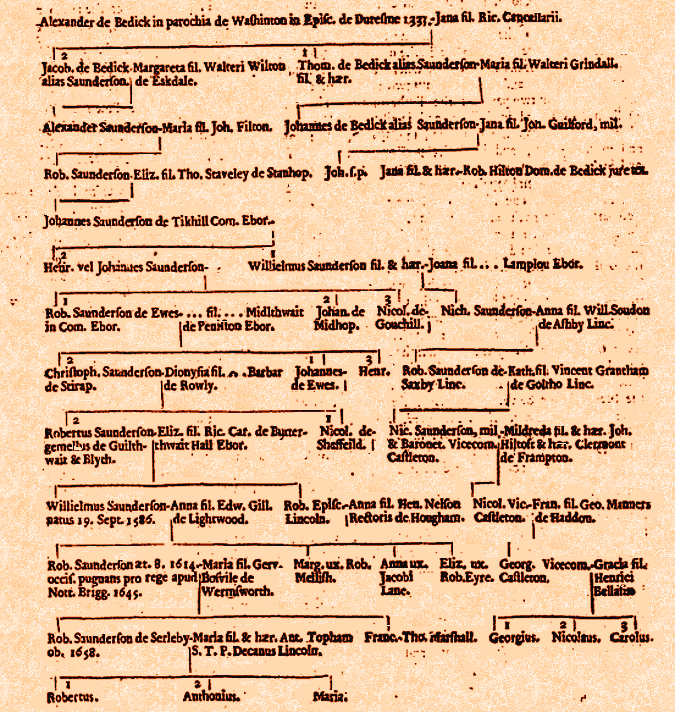

Robert's mark
|
|
Our family's lineage can (probably) be traced back to England with brothers ROBERT SANDERSON and EDWARD SANDERSON, and possibly a cousin or nephew named WILLIAM SANDERSON, who all sailed from England to the New World at different points in the early 17th Century.
Evidence points to their hometown in England as being a parish and market town called Higham Ferrers, in the Nene Valley in East Northamptonshire, close to the Cambridgeshire and Bedfordshire borders, 15½ miles (E. N. E.) from Northampton, and 65 (N. N. W.) from London. Higham Ferrers Castle was one of the baronial castles built shortly after the Norman Conquest, and the town was the birthplace of the birthplace of Henry Chicheley, Archbishop of Canterbury from 1414 to 1443. It was also the location of one of the few families in England at the time using the rare spelling of Saundersonne. And it was probably there that Robert, the most famous of the brothers, was born in about 1607 (based on the age given in a deposition taken later in life). Then on 17 Oct 1623 he was entered in the London register of the Goldsmith's Guild (he wrote "Higham" as his birthplace), and he apprenticed to William Rawlins from 1626 to 1635 in London. His official mark (shown at right) was registered at Goldsmith's Hall in London in 1635. Robert then transferred his training to the goldsmith George Dixon in 1638. Other Saundersons in the area began working in the same trade: In 1640, a yeoman from Pilton (about 12 miles from Higham Ferrers) named William Saunderson apprenticed his son Thomas to Thomas Judd, Goldsmith. In 1651, William Saunderson of Pilton then apprenticed his son Nathaniel to Thomas Saunderson, Goldsmith. However, Currier and Bond's genealogy claims Robert was from Norfolk, England, which is ninety miles away from Higham Ferrers. Unfortunately, the vital records for the period have been lost, so we may never know the precise genealogy of Robert or his brothers.¹

Robert's apprenticeship to William Rawlins, registered in the Goldsmith Guild: "I Robert Sanderson the sonne of Saundersonne of Higham doe put myselfe apprentize until William Rawlins Citizen & Goldsmith of London for the terme of nyne yeares." (click to enlarge.) |
At some point during Robert's tenure as an apprentice (probably 1632 or 1633) he married a woman named LYDIA and started a family in London. There is a "Mr. Sanderson" in the 1638 Rent book for the parish of St Mary Abchurch, where he and Lydia christened children (T C Dale, 'St. Mary Abchurch', from The Inhabitants of London in 1638 [London, 1931], pp. 105-106). But soon after that, Robert, Lydia and their daughter sailed for the American colonies—a fortune was to be made there as a silversmith.
The precise date of Robert's arrival with Lydia is unknown. About twenty ships arrived during the spring of 1638 with at least 3000 immigrants, and Governor John Winthrop ceased to record separate arrivals of passenger ships due to the massive influx of people. Watertown, the main area of settlement, had ceased granting land in 1635, and the General Court of Massachusetts Bay Colony was "forced to look out to new plantations." So on 2 Nov 1637 the General Court of Massachusetts Bay Colony passed a covert making a grant of territory known as "Winnacunnett" (later known as "Hampton"), and it became the area where Robert and his family (and possibly a relation named William, as a "William Saunders" was listed in the settlement, a carpenter who came over as a servant) first made their home.
Winnacunnet, or as Winthrop spelled it, "Winicowett," was settled by a number of Puritan families from Norfolk county, England, and led by Reverend Stephen Bachiler. According to Bachiler's letter to John Winthrop, Jr., the plantation was settled on October 14, 1638. That same Autumn the court had also designated the "last Thursday of the 8th month" (October 25) as a public day of thanksgiving in appreciation of the good spring weather, the ripening harvest, and the "safe coming of so many ships this year," so the Sanderson clan may have celebrated their first Thanksgiving there on the 25th. Reverend Bachiler an early proponent of the separation of church and state in America, and was eventually forced to leave the town because of his scandalous behavior. However, he gave the town its permanent name of Hampton. Robert was made freeman on 7 Sep 1639, and began raising a family there with Lydia. That family consisted of:
CHILDREN OF ROBERT SANDERSON AND LYDIA (?) |
|
ROBERT SAUNDERSON II was born on 26 Feb 1633 to parents "Robert Saunderson" and "Lidia" according to records at Saint Mary Abchurch, London, England (according to FHL Film Number: 374483). He must have died soon after, because there is no record of him coming to the New World with his parents. There is no confirmed proof that this is the same Robert and Lydia Sanderson in our lineage, but it did occur in the same parish as their next child...
|
|
LYDIA SANDERSON was born on 21 Jan 1635 in London to parents Robert and Lydia Saunderson (according to England Births & Baptisms 1538-1975 and birth/christening record for St Mary Abbey Church, London, London Co., England; Film: 374483 1558-1812), and came to the New World with her parents. On 13 Dec 1654 she married Thomas Jones (b. 1632) in Boston, Mass. (click on marriage record at right. SOURCE: Massachusetts, Town and Vital Records, 1620-1988, Holbrook Research Institute), and had the following children: Mary Sanderson Jones (1655-1728), Lydia (b. 1659), Thomas (1662-1723), Joseph (1664-1721), and Hannah Jones (b. 1675).
|
|
MARY SANDERSON (CROSS?) was baptized on 2 Sep 1639 in Hampton, N.H. (Source: Genealogies of the Families and Descendants of the Early Settlers of Watertown, by Henry Bond, 1860. Volume I, p.416, 417.) Mary was "the first white child born in Hampton." (Source: Hands that built New Hampshire, 1940.) She possibly married James Penniman (b. 1642), as Robert bequeathed £5 to the "children of James Penniman" in his 1693 will. No birth or marriage data can be found, except for the marriage of a James Penniman to Mary Cross on 10 May 1659 in Boston (click on marriage record, at right); Could she have been born to Mary Cross and her first husband, but raised by 2nd husband Robert? Bond notes: "John Cross, of Wat., probably a son of the preceding, by wife Mary, had dr. Mary, b. (posthumous) May 10, 1641."
|
|
| Land Grant Information |
Image |
|
| Name: |
|
Saunderson, Robert |
| Acreage: |
|
Farm (13 Feb 1640) |
| Acreage: |
|
4 acres in the South Field (14 Jul 1640) |
| Town: |
|
Hampton, New Hampshire |
|
|
|
SOURCE INFORMATION: "Hampton Records, Volume I." Author: A.W. Bialobrzeski, NHLLS #752 and Hampton Historical Society, pages 40, 48. Available online here.
|
There is no evidence that Robert practiced smithing while living in Hampton. Silversmiths were rare in early America because the life was so primitive, and earler settlers would have to get their supplies from the larger settlements. It was hard to establish yourself a trade in the social order of Colonial Massachusetts. The majority of the workforce in Colonial Massachusetts consisted of manual workers, servants, apprentices, sailors, hired hands and semi-skilled tradesmen. These were colonists of the lower class could not vote nor hold public office. Few owned property and most were illiterate. The lower classes were bolstered by Indentured Servants and some slaves. The Middle class citizens of Colonial Massachusetts, to which Robert belonged at this point in life, could vote but few held public office. They ran stores or small businesses, were skilled tradesmen or belonged to professions. The Upper class consisted of wealthy and well-educated minor aristocrats who could vote and held high public office.
While Robert wasn't yet able to establish himself as a silversmith, records show that he did work in agriculture, and he acquired farmland over the course of the year 1640 (see land records, at right). He was working his way up in colonial society.
On 16 Apr 1641, Robert was fined 12d (shillings?) for being absent from a town meeting (meetings were held at noon and fines began if absent for over an hour.) He was fined again for missing a meeting on 7 May 1641.
According to the book Historic Silver of the Colonies and Its Makers by Francis Hill Bigelow, after three years in Hampton, Robert and Mary moved to Watertown, Middlesex, Massachusetts, where his nephew William Sanderson lived. William Sanderson was likely Robert's cousin ("cousin" was not used commonly then, but "nephew" and "kinsman" were). The book claims that William was born four years before Robert. (Bigelow was a descendant of the Watertown blacksmith.) Watertown, first known as Saltonstall Plantation, was one of the earliest of the Massachusetts Bay settlements. It was begun early in 1630 by a group of settlers led by Sir Richard Saltonstall and the Rev. George Phillips and officially incorporated that same year (today it's a part of the Greater Boston area). The first buildings were upon land now included within the limits of Cambridge known as Gerry's Landing. For its first quarter century Watertown ranked next to Boston in population and area. (Since then, its limits have been greatly reduced.) Robert got his first land in eastern Watertown through Mary's holdings. According to the Watertown Records, he acquired two lots on Common Hill, also known as Pequusset Hill (now "Pequossette"), and later Payson Hill, split by Hill Street, now called School Street in present day Belmont, Massachusetts.
According to the book "Hands that built New Hampshire: the story of granite state craftsmen past & present:""The first New Hampshire silversmith of which there is any record was Robert Sanderson, a highly trained English 'goldsmith'. In 1638, at the age of thirty, he took up eighty acres in the town of Hampton and lived there for four years. Then he went to Boston, where he became associated with his friend, John Hull, silversmith and master of the mint which was established by the General Court in Boston, 1652. There are no proofs that Sanderson ever worked at his trade in Hampton. The only evidence of his New Hampshire sojourn is found in the neglected grave of his wife, Lydia; in the tradition that his daughter, Mary, was the first white child born in Hampton; and in the positive record that he owned property on the plantation."
 |
The line about the "neglected grave of his wife, Lydia" seems to imply that the authors knew of a gravestone for Robert's wife in Hampton (probably at the Pine Grove Cemetery, pictured above).
But Robert married again: to MARY CROSS (1617 - 21 Jun 1681) in Hampton sometime around 1642. She was allegedly the widow of John Cross, and they had sailed to America on the same ship as the Sandersons. No proof of this has ever been found, however.
EDWARD SANDERSON
It was about this time that Robert's brother EDWARD SANDERSON (1611-1696) first appeared in the record. We don't know the exact date he arrived, but some sources list it as 1645 (Founders of Early American Families; Emigrants from Europe, 1607-1657, by Meredith Bright Colket, Jr. Cleveland: General Court of the Order of Founders and Patriots of America: distributed by Founders Project, 1975; page 253). Edward settled in Watertown, as well.
In September of 1645, Richard Linton sold Robert his dwelling house and lot of eight acres, immediately south of Robert's land on the map, below. The purchase date was a month before Edward married MARY EGGLESTON in Watertown, on 16 Oct 1645 (perhaps it was meant as a place to stay for the newlyweds).
Mary was born in England, exact location unknown. Her parents are unknown. It has been speculated that she was the daughter of Bygod Eggleston of Windsor, baptised in Norwich in 1614, but that is unlikely for several reasons. It is known that she married Edward Sanderson on October 16, 1645 in Watertown, Massachusetts. Bigod's daughter born in 1614 would have been over 30 by that time. Also, Bigod did not name her or any of her children in his will, and the Egglestons of Windsor had no known connection with Watertown, which was a long way from Windsor in those days.

Robert's property in Watertown, west of the "Fresh Pond," based on the property records in 1642. His house was on the first homestall of 6 acres listed in the records and that was west of Hill Street. The lot east of Hill Street was four acres of swamp land. It was considered a meadow by 1713, according to a deed of sale by Robert Jr. Today it is a residential district between Shaw Road and Livermore Road. |
|
| Personal Information |
Marriage License |
|
| Name: |
|
Sanderson, Edward |
| Spouse: |
|
Egellston, Mary |
| Town: |
|
Watertown, Massachusetts |
| Date: |
|
16 Oct |
Year: |
|
1645 |
|
|
|
SOURCE INFORMATION: Town and City Clerks of Massachusetts. Massachusetts Vital and Town Records. Provo, UT: Holbrook Research Institute (Jay and Delene Holbrook)
|
Edward took the oath of allegiance in Watertown in 1653, something you had to do to own land. There was no deed of sale, so he may have been given the land in one of the town's land divisions, in which the town's land was divided between the original proprietors. He may also have been helped by Robert, or perhaps he drained the swamp land and bought that, but eventually Edward owned a homestall with a house, a barn and a meadow. He sold his own property to neighbor William Shattuck, Sr. in 1664. (Shattuck mentioned the house and land he had bought from Edward Sanderson in his will.) Edward then moved to western Watertown in 1664 (it became Waltham in the 1700s), where he had purchased 12 acres just south of Fisk Pinnacle. Waltham historian, genealogist and a founding member of the Waltham Historical Society, Edmund L. Sanderson, who grew up in one of the old Sanderson family homes in Waltham in the late 1800s, believed Edward Sanderson's 12 acres were in the area of the north campus of what is today Brandeis University. Edward and his wife had a son named Jonathan (b. 15 Sep 1646), about one year after their marriage, but they also had other children who weren't listed in the town records. Here are the children we know of:
CHILDREN OF EDWARD SANDERSON AND MARY EGGLESTON
|
 |
(DEACON) JONATHAN SANDERSON was born in Watertown, Massachusetts, on 14 or 15 Sept 1646. Jonathan deposed in 1696, saying he was 49, and that he had lived with Justinian Holden when he was 17 on Holden's large farm on the Cambridge-Watertown line. On 24 Oct 1669, Jonathan married Abia Bartlett (1651-1723), daughter of Ensign Thomas and Hannah Bartlett, in Cambridge. Jonathan and his bride moved to the adjoining farm, called "Hassel's Farm," and lived there for 21 years. Abia and Jonathan had eight children, all born in Cambridge. (The youngest was born in Cambridge but baptized in Watertown, so the family must have moved to Watertown between May and July of 1689.) The family moved to the area known as "Piety Corner" in Watertown, which would someday be set off as Waltham. Jonathan served as constable in Watertown in 1695 and was referred to as "Serjant Sanders." He was chosen selectman in 1702, this time being called "Deacon Jonathan Sanderson." He served three more years a selectman, then in 1711 was chosen Representative to the "Great and General Court" from Watertown, where he served two terms. After that, he served two more terms as selectman and was chosen Representative again in 1716, but declined the office. The last mention of Deacon Jonathan Sanderson Sr. in the Watertown records was in 1733, when land between Old Deacon Sanderson and Allen Flegg was chosen for a schoolhouse. Jonathan wrote his will on April 2, 1728, and named his sons John and Jonathan as executors. He died in Waltham, Middlesex County, Massachusetts, on 3 Sep 1735, aged 89 years. His grave is in the old or lower graveyard at Waltham, known as Grove Hill Cemetery.
|
| HESTER SANDERSON was born on 12 Mar 1652 (The New England Historical & Genealogical Register Vol 127; Boston: The New England Historic Genealogical Society; Page 182) and baptized in Watertown in 1686, described as a "young person." (SOURCE: "Edward Sanderson of Watertown, Mass," by Page Sanderson, The New England Historical and Genealogical Register #127, Jul 1973)
|
| ABIGAIL SANDERSON was born in 1660 (Godfrey Memorial Library: American Genealogical-Biographical Index, Vol. 152, page 481. Middletown, CT, USA: Godfrey Memorial Library; Gen. Column of the Boston Transcript, 19 Aug 1912, 2696) and was married on 27 Oct 1687 to Shubael Child in Watertown; Abigail died on 8 Oct 1693, and Shubael shortly thereafter became mentally ill, was locked in an unheated jail in the middle of winter and froze to death. They had two sons: Richard (9 Apr 1690 - 21 Oct 1712) and Shabuel Child (8 Sep 1693 - 24 Sep 1756).
|
| HANNAH SANDERSON (b. @1670) was married on 6 Aug 1695 to schoolmaster Richard Norcross (4 Aug 1660 - 1745) in Watertown. They had a grandchild, Edmund Mason, under their care (bap. 16 Dec 1739). They hd the following children: Hannah (b. 16 Feb 1698-9), Joseph (b. 1 Jul 1701), Jeremiah (b. 2 Jul 1703), George (b. 22 Aug 1705), Rose (b. 20 Mar 1707-8, "to be called Ruth"), Peter (b. 28 Sep 1710), and William Norcross (b. 14 Mar 1714-15). She died on 14 May 1743 in Weston, where they had settled. (SOURCE: "Edward Sanderson of Watertown, Mass," by Page Sanderson, The New England Historical and Genealogical Register #127, Jul 1973)
|
There are no official records of other children born to Edward and Mary Sanderson in Watertown, but in January of 1661, town records show that they had six children who were illiterate, and the family was becoming a burden—not only for Edward, but for the town itself. The family was one of four identified by the selectmen as providing an inadequate education for their children. In a town meeting of 28 Jan 1664 the town gave Edward money to support his family. Later in May, the town voted to give Edward three bushels of Indian corn. In 1671, a town clerk wrote that Edward was indigent and two young daughters (probably Hester and Abigail) were apprenticed out, to ensure their education and relieve the financial burden on the family. In 1663, Jonathan, the eldest child, worked as a servant for Justinian Holden of Cambridge for 4 or 5 years, beginning at the age of 17. Watertown paid for the care of Edward's children at least through 1676. (Edward also may have had a son named John in England by Elizabeth Brightman.)
As a silversmith, Robert Sanderson would have enjoyed a great many advantages over his brother. His work was highly sought after, because until that time, Colonists in the New World only used what utensils they could make. The first plates and spoons were probably made of wood. This early ware was known as "treen"—a term derived from the word 'trees.' But there were also pewterers among the early settlers, and they were soon making spoons and plates of pewter.
As Robert's business grew, prosperous citizens and clergy took their coins to him and had them melted down and fashioned into household articles—spoons, tankards, and porringers. After melting the coins, Robert refined the metal, and poured it into a skillet to form a flat block of silver. The block was hammered out to the desired thickness and worked into whatever article the patron ordered. The metal was worked while cold, but was repeatedly heated over charcoal to prevent brittleness and to make it tougher. This process was called "annealing."
A finished article was polished by rubbing with pumice and then with a burnisher. This method did not cut away the surface but simply rubbed it smooth while leaving some hammer marks. Collectors feel that these marks add to the charm of a piece of old silver. The surface of antique silver has a patina rather like that of fine old wood and rubbing. Furthermore, since each piece was made by hand, no two were alike.
A merchant who had his coins made into household articles would have them engraved with initials or crest. In this way his wealth in silver was useful; it was still an investment, but it was not likely to be stolen, for initialed silver was fairly easy to trace. Old records show that sometimes articles of silver were stolen, but after advertisements appeared with a detailed description of some family piece, it was usually returned and the thief punished.
Because of this, Robert Sanderson would become one of the most prosperous men in the colonies: He added to his holdings in Watertown by purchasing William Godfrey's land and house, about 6½ acres or so, on 3 Sep 1653. Possibly the same William Sanderson mentioned above lived on this property for a time after Robert moved to Boston. William testified about the drowning death of Thomas Hastings' son, and Hastings owned property just south of the property.
Meanwhile, Robert's family grew, too:
CHILDREN OF ROBERT SANDERSON AND MARY CROSS
|
|
JOSEPH SANDERSON was born on 01 Jan 1645, in Hampton, Rockingham, New Hampshire (click on birth notice, at right. SOURCE: Massachusetts, Town and Vital Records, 1620-1988, Holbrook Research Institute). Apprenticed about 1658 to Robert Sanderson in Boston. John Hull's diary on 8 Nov 1658 reads, "Robert Sanderson and his son Joseph were very ill and lost several days work before they recovered." He worked from circa 1663 to 1666 as a silversmith in Boston. No work by his hand is known to survive, though outstanding orders for silver at the time of his death and the number of tools in the shop inventory (conducted by Jeremiah Dummer and Samuel Paddy) indicate that he was active in the trade. Joseph died when only 25 in 1667. (See his Suffolk Co. Probate Inventory here.) Just before his widow's remarriage, a deed dated Dec. 21, 1681, made arrangements for property of Joseph Sanderson's children.
|
|
BENJAMIN SANDERSON was born on 29 Jul 1649, in Watertown, Middlesex, MA. Christened: 29 Jul 1649 (click on baptism notice, at right. SOURCE: Massachusetts, Town and Vital Records, 1620-1988, Holbrook Research Institute). Benjamin married Mercy Viall about 1672 in Boston MA. (Mercy Viall was born on 11 Mar 1649 in Boston MA and was christened on 18 Mar 1649 in Boston MA.) Children: Boston Births, 1630-99 records the birth of Mary, 1677; Benjamin, 1674; and Joseph, 1673, all children of Benjamin and Mary Sanderson. Benjamin apprenticed about 1662 to Robert Sanderson and John Hull in Boston. He worked from circa 1670 to 1678 as a silversmith in Boston. He signed a will on 11 Dec 1678, on file in Suffolk Probate, it names his father as executor, and the North Church and Mary Sinderlin [sic], his wife's sister, as legatees, stating "the rest of his Estate might be for some honest Poor persons. . ."
|
|
SARY (SARAH) SANDERSON was born on 18 Jan 1651, in Watertown, Middlesex, MA. Christened: 18 Jan 1651, Watertown Middlesex MA (click on baptism notice, at right. SOURCE: Massachusetts, Town and Vital Records, 1620-1988, Holbrook Research Institute). She married Robert Darbey (b. 1647) and they had a son, Robert Darby II (1679-1759). Sarah probably died before Robert's will of 1693, but Robert did bequeath £10 to "grandson Robert Darby."
|
|
ROBERT SANDERSON was born on 22 Oct 1652, in Watertown, Middlesex, MA, and christened on 22 Oct 1652. Apprenticed about 1665 to Robert Sanderson in Boston MA. He worked from circa 1680 to 1693 as a silversmith in Boston MA as a journeyman in his father's shop. Examples exist from this period stamped twice with the elder Sanderson's mark, the second indicating the assistance of his son. He worked from circa 1673 to 1679 as a silversmith in Boston MA as a journeyman in his brother Benjamin's shop. It appears that he left the trade atfter his father's death. (SOURCE: Kane, Patricia E., Colonial Massachusetts Silversmiths and Jewelers.) He died on 11 Apr 1714 in Boston, Suffolk, Massachusetts (click on death notice, at right. SOURCE: Massachusetts, Town and Vital Records, 1620-1988, Holbrook Research Institute).
|
|
JOHN SANDERSON was born about 1654, in Watertown, Middlesex, MA. He apprenticed before 1658 to John Hull in Boston. According to John Hull's diary on 1 Sep 1658, "My boy John Sanderson, complained of his head aching, and took his bed; a strong fever set in, and after 17 days' sore sickness, he departed this life." (Click on death notice, at right. SOURCE: Massachusetts, Town and Vital Records, 1620-1988, Holbrook Research Institute)
|
|
ANNE SANDERSON was born about 1654, in Watertown, Middlesex, MA. She married a man named Richard West, according to Robert's will (see marriage record, at right. SOURCE: Torry, Clarence A. New England Marriages Prior to 1700. Baltimore, MD, USA: Genealogical Publishing Co., 2004). She died in 1723, in Rehoboth, Bristol, Massachusetts.
|
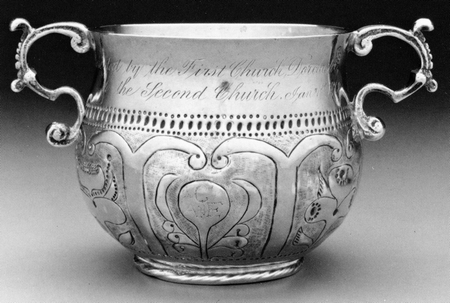
Caudle cup for the Second Church of Dorchester MA; Engraved "C over A E" for Augustine and Elizabeth Clement and "The gift of Mrs Elizabeth Clement to the Church of Dorchester, 1678." No, you can't afford it.
|
| There may have been other children, including a daughter, Abigail, who was never recorded until Robert's third wife was instructed to care for her in their marriage contract (this may also have been the daughter of Edward, however). Another son, John (listed above), was only identified because his death was mentioned in the records of John Hull.
Robert next moved to Boston, where Robert forged the next great partnership in his life, with John Hull, another silversmith from London—and probably the first one to work in Boston. Together, Sanderson and Hull would create some great work... and become very rich in the process.
With Hull, Robert became a Master of the Massachusetts Mint for many years, creating the first money recognized by the state. His work and social life flourished and he became a deacon, hobnobbed with the most prominent Bostonians, and was frequently appointed to high positions of trust.
The first silver articles made by Americans were spoons. (Knives and forks were not in general use until the eighteenth century.) Today American spoons of the seventeenth century are rare, although many must have been made. The reason for their scarcity today is probably because they got such hard use that they had to be melted down and reformed, either into a later spoon design or into other articles. But whatever the reason for scarcity, the few early spoons known to still exist today are in museums or private collections.
One fine early spoon with the mark of Sanderson and Hull is in the Essex Institute in Salem, Massachusetts (you can see it in the top photo). It has a large bowl like a fig, and the handle is a straight piece. This type, usually called the "Puritan spoon," is the earliest known design in this country.
|
A cup, a caudlecup and a tankard created by Robert Sanderson, between 1670-1680, on display in the Boston Museum of Fine Arts. The tankard was made for Isaac and Mary (Balston) Vergoose. This is the only tankard known from the first generation of American smiths.
|
After the spoon, the porringer, bowl, and tankard were made by silversmiths for food and drink. Liquor in some form was generally enjoyed by everyone in those days, even by the clergy. Those who could afford it had these articles made of silver. The tankards were usually made large to hold the large quantities of liquor necessary to stay warm in a cold climate. (At least that was the excuse.)
Because the settlers of New England were religious (mostly Puritan), the first silver made there was usually for churches and reflected the simple tastes of the people. Even today many New England churches are proud owners of early silver that has been treasured for generations. (Robert was a member of the First Church in Boston, and made many silver products for his place of worship. You can see his work for the church in the Museum of Fine Arts today.)
Robert worked from 1652 to 1683 with Hull in Boston, partnered as HULL & SANDERSON. This partnership produced many fine pieces of silver, always identifiable with Hull and Sanderson's marks. They were New England's first master silversmiths, and created the earliest known piece of American silver: a dram cup made by the partners, now in the Yale University Art Gallery. (In 2001, their work earned the record bid for American silver made circa 1660—$775,750.)
THE FIRST MONEY IN AMERICA
|

Before 1652, the Colonies had no currency. Only the king held the power to issue coins in the British colonies. But in 1649 rebels in England beheaded Charles I, leaving Massachusetts struggling to maintain its economy with little hard currency. So in 1652, the General Court approved establishing America's first mint, and John Hull was made mintmaster by the General Court of Massachusetts. When Hull was named master of the Mint, he took Robert, a more accomplished silversmith and whom he called "another godly goldsmith," into partnership. Despite this godly nature, Hull cut an outrageous deal with the British—his share in the profits of the mint was fifteen pence out of every twenty shillings—and soon he became the wealthiest man in America. His daughter Hannah married Samuel Sewall, who went on to become one of the judges at the Salem Witch trials (killing off one of our Wenk ancestors, JOHN PROCTOR). On the day of Hannah's marriage, Hull placed his daughter, as tradition says, in one of the scales and heaped silver New England shillings in the other. When the scales finally balanced, the wedding present amounted to £3,000! Robert did pretty well, too (rumor has it that later in life, he kept minting coins even after their contract with the British was up).
Hull & Sanderson produced the willow-tree, oak tree, and pine-tree shilling used in the New England Colonies until 1683. A mint committee document dated 11 June 1652 recorded the oath of office created for the deposition of the mintmasters: "Itt is Ordered that the Oath here vnder written shall be the oath that John Hull and Robt Saunderson shall take as aequall officers In the minting of mony &c." The oath then began as follows: "Whereas yow : John Hull and Robert Saunderson are Appointed by the order of the Gennerall Courte bearing date the 10th of June 1652. to be officers for the massachusetts Jurisdiction in New England, for the melting, Refyning, and Coining of silver..."
Customers brought in silver buttons, tankards, goblets, knives, old sword hilts, spoons and European coins which were melted down and converted into the coinage. Hull and Sanderson's fee was handsome—they kept one out of every twenty shillings minted—plus "wastage" (leftover scraps)—but their risk was great as well, because they were defying a restriction imposed by the English government which forbade private coinage in the colonies. But the Pine Tree Shilling was so useful in the colonies that the English government chose to ignore its existence rather than attempt to suppress its circulation—which was an important early step toward American independence.
|
On October 1, 1683, John Hull died. It isn't known whether Sanderson continued to work at the mint after Hull's death—since all of the coins were marked "1652," it's impossible to know if he kept minting them. There is no evidence as to when the mint actually closed its doors. Sanderson could have kept the operation going on a part time basis until the silver supply was depleted. A series of letters from the London mint and the Royal Treasury dated from 1684 through 1686 list several objections to the reestablishment of the Boston mint, so we can assume the mint was defunct by that time. But Sanderson continued to work as a silversmith after Hull's death.
Mary died on 21 Jun 1681 and is buried at the Granary Burying Ground, in Boston, Suffolk County, Massachusetts (inscription: "74yrs, wife of Robert, Sr."). Founded in 1660, the Old Granary Burial Ground is located on Tremont Street, adjacent to Park Street Church and immediately across from Suffolk University Law School. (It's also the final resting place for three signers of the Declaration of Independence, Paul Revere, and the five victims of the Boston Massacre. The cemetery has 2,345 graves, but historians estimate as many as 5,000 people are buried there.)
"William, son of Robert (i), at Hampton, N. H., 1641, m 18 Dec, 1666, Sarah. They rem from Watertown after the birth of his seven ch to Groton, but owing to Indian troubles they returned to Watertown."
—"History of the town of Whately, Mass" (1899), on p. 546.
|
| Personal Information |
Marriage License |
|
| Name: |
|
Sandors, Willyam |
| Spouse: |
|
Sary (?) |
| Town: |
|
Watertown, Massachusetts |
| Date: |
|
18 Oct |
Year: |
|
1666 |
|
|
|
SOURCE INFORMATION: Town and City Clerks of Massachusetts. Massachusetts Vital and Town Records. Provo, UT: Holbrook Research Institute (Jay and Delene Holbrook)
|
|
But there was a third line of Sandersons in Watertown, as well. It begins with WILLIAM SANDERSON, whom we know is related to Robert, but the actual connection has never been definitively proved. Many books and genealogies list William as a son of Robert, but is actually called a nephew in Robert's will (page 4 of probate, shown below).² Some speculate that he was actually a cousin from Higham Ferrers, or the son of Edward (a William Sanderson was caught drinking with Justinian Holden, Jr., in May of 1666, while Edward's son Jonathan was working as a servant to Justinian Holden, Sr.). But his birth pre-dates Edward's marriage. All that can currently be known from studying DNA, deeds, wills and town and churchbook records, is that he was certainly from the same family, and he joined them in emigrating to Watertown.

|
In the book, Divided We Stand, author Roger Thompson describes the "peopling" of Watertown. He writes that many of the newcomers who came after the first two waves of migration were actually extended family members of the original settlers. It then makes sense that Robert would assist other members of his family in emigrating to Massachusetts. With that in mind, Robert bought neighbor William Godfrey's house and property while he was leaving for Boston, possibly as a place for William to stay—as he likely did for brother Edward at the time of his marriage, buying the Linton house (Robert retained ownership of his Watertown properties—but he did not list them as rental properties, unlike his properties in the Boston area).
William's year of birth is generally given as 1641, based on information given during a deposition in 1681 when he declared his age as 40. However, a William Sanderson was also deposed in 1683, and this William's age was given as 48. This would make his birth year 1635 (if it's even the same guy, as more and more undocumented people were settling in Watertown).
William married a girl named SARY (b. 1645) on the 18th of December, 1666, in Watertown, Middlesex County, Massachusetts. Sary was a member of the church, but it seems that William was not. When the children's baptisms were recorded, the records say that Sary "owned the covenant"—meaning that she was a full church member, while William was not identified as such. Their children are listed here:
CHILDREN OF WILLIAM AND SARY SANDERSON
|
|
JOHN SANDERSON was born on 13 Oct 1667, Watertown, Middlesex, MA. "John Sandors, son of Willyam & Sary Sandors Borne the 13day of october" (SOURCES: Watertown records: comprising the first and second books of town proceedings with the lands grants and possessions, also the proprietors' book and the first book and supplement of births and deaths and marriages Historical Society of Watertown (Mass.). Watertown, MA, USA: Fred G. Baker, 1894 (Click on birth record at right, p.29); Genealogies of the Families and Descendants of the Early Settlers of Watertown, Massachusetts, Including Waltham and Weston : to which is appended the early history of the town, by Henry Bond, M.D. Boston: Published by the N. E. Historic-Genealogical Society, for the benefit of the "Bond Fund." 1860.)
|
|
SARY ("SARAH") SANDERSON was born on 17 Mar 1668, in Watertown, Middlesex, MA: "Sary Sanderson, daughter of Willyam and Sary Sanderson" (click on birth record, at right), according to Massachusetts, Town and Vital Records, 1620-1988 (Holbrook Research Institute). She married Andrew White (1669-1742) on 4 Feb 1695/96 in Woburn, Middlesex, Massachusetts, and they had the following children: Sarah (1696-1723), Andrew (1700-1790), William (b. 1702) and Hannah White (1708-1781). Sary died on 31 Dec 1749, in Watertown, Middlesex, MA.
|
|
WILLIAM SANDERSON II was born on 06 Sep 1670, in Watertown Middlesex MA: "Willyam Sandor, son of Willyam and Sary Sandor" (click on birth record, at right. SOURCE: Massachusetts, Town and Vital Records, 1620-1988, Holbrook Research Institute). He is in the will of Robert Sanderson ("son of Nephew William") and was to receive whatever land was involved if Robert, Jr. was to die. William, Jr., was married on 4 May 1704, to ANNA SHATTUCK (1677-1740) in Watertown (click on their marriage notice here. SOURCE: Massachusetts, Town and Vital Records, 1620-1988, Holbrook Research Institute). Their children are listed below. William II died in Sudbury or Farmingham, MA, sometime after 1720. Anna died in 1740 in Sudbury, MA.
|
|
MARY SANDERSON was born on 30 Sep 1671, in Watertown, Middlesex, MA., listed as "Mary Sandors, daughter of Willyam and Sary Sandors" (click on birth record, at right), according to Massachusetts, Town and Vital Records, 1620-1988 (Holbrook Research Institute). She moved back to Watertown, with her family: "Ye 13th of January 1688/9 Mary Sanderson ye daughter of William Sanderson, she owned ye Covenant" (Watertown Records, Volume IV Marriages). She was willed 20 shillings by Elizabeth, Robert Sanderson's third wife, in 1695. (It does not list a married name.)
|
|
HANNAH SANDERSON was born on 08 Mar 1674, in Groton, Middlesex, MA, listed as "Hannah Sanders, daughter of Wm." (Click on birth record, at right), according to Massachusetts, Town and Vital Records, 1620-1988 (Holbrook Research Institute). She returned with her family to Watertown, and was confirmed in 1688: "Ye 8th of Aprill 1688 2 young Psons who owned ye covenant,viz William & Hannah Sanderson, ye children of William Sanderson" (Watertown Records, Volume IV, Marriages).
|
|
LYDIA SANDERSON was born on 21 Apr 1679, in Watertown, Middlesex, MA, ("Lydia Sanderson, daughter of Willyam and Sary Sanderson"(click on birth record, at right), according to Massachusetts, Town and Vital Records, 1620-1988 (Holbrook Research Institute). "Ye 20th of May 1688 3 children, a child of Samuell Jennisons called Lidia, & 2 of Sarah Sandersons (ye wife of William Sanderson) who owed ye Covenant, viz Joseph & Lidia" (Watertown Records, Volume IV Marriages). She was willed 40 shillings by Elizabeth, Robert Sanderson's third wife, in 1695. No married name given.
|
|
JOSEPH SANDERSON was born on 28 Aug 1679/80, in Watertown, Middlesex, MA: "Joseph Sanderson, son of Willyam and Sary Sanderson" (click on birth record, at right. SOURCE: Massachusetts, Town and Vital Records, 1620-1988: Holbrook Research Institute), and eventually settled in Groton. He married Sarah, daughter of Samuel and Hannah Page. He was willed £5 and a "musquet" by Robert Sanderson in 1693. Joseph had a son with Bethiah Kemp, named Joseph Jr., born 30 Aug 1713 in Groton, as determined by the courts in a 1714 bastardy case. However, Y-DNA testing has determined that Joseph Jr. was actually fathered by a man named "Lakin."² Joseph Sr. died in 1736, in Groton, Middlesex, MA.
|
|
| Book Information |
Book Image
|
|
| Name: |
|
Genealogical and Personal Memoirs Relating to the Families of the State of Massachusetts |
| Author: |
|
William Richard Cutter, A. M. |
| Publisher: |
|
Lewis historical publishing company |
| Year: |
|
1910 |
| Pages: |
|
503-505 |
|
|
|
|
A genealogy of the William Sanderson line.
|
|
Unfortunately, William appears to have inherited no talent for smithing. He was a simple farmer in Watertown who had to struggle to survive, like most everybody else. Thiswas made harder because by November 1635, Watertown was declared "full" and would accept no more proprietors.
But Robert's fame and fortune continued to grow, and he apprenticed his sons: Joseph Sanderson (1653 in Boston), Benjamin Sanderson (about 1662 in Boston), and Robert Sanderson (about 1665 in Boston). It took seven years of apprenticeship to develop a silversmith in this country, from ages 14 to 21. But the Sanderson dynasty was not to be: Joseph and Benjamin died young. Benjamin, apparently embittered toward his siblings, ignored them all in his will, dated Dec. 11, 1678, on file at Suffolk Probate. It names Robert Sr. as executor and the North Church and Mary Sinderlin, sister, as legatees, stating "the rest of my estate to be given to some honest Poor persons." Robert, Jr., was the only son to survive his father and carry on the business in Watertown. However, his mark and therefore his products, have not been identified.
Besides his work in the shop and at the Mint, Robert Sr. was active in town affairs, serving as constable in 1662 and deacon of the First Church starting in 1670 and serving until the end of his life. Mary died on the 21st of June, 1681, in New Haven, Connecticut. In Granary Cemetery, her inscription reads: "Here lyes ye body of Mary late wife of Robert Sanderson, Sen'., age 74 years, died June 21, 1681, and her grandson in grave with her." (This grandson was probably Sanderson West, who was the baby at that time.)
In 1681, in the months after the death of his second wife, Robert was preparing to marry for the third time, and he created a deed to ensure that his new wife, Elizabeth, the widow of the Quaker William Kingsmill, would be taken care of after his death. In return, Elizabeth agreed to take care of his daughter Abigail, who was incapable of caring for herself. Abigail's birth is not recorded.
MARRIAGE CONTRACT (Suffolk County Deeds, 12:125-26)
|
| Whereas there is a purpose of marriage by God's grace shortly to bee solemnized Between Robert Sanderson of Boston in New England Gold Smith & Elisabeth Kingsmill of sd. Boston widow; And forasmuch as the sd. Robert Sanderson out of the intire Love Sandereon and affection which hee hath and beareth unto the Davie sd. Eliz": is willing and desirous to make provision for her comfort and Subsistance in ease Shee should Survive him Hath granted assigned enfeoffed and convayed, and -by these presents Doth fully and absolutly grant assigne en- feoffe convay and confirme unto Humphry Davie Esqr. and mr. James Allen both of sd. Boston ffeoffees in trust for the sd. Elizabeth all his Mantion house with the two Orchards garden and all the land thereto belonging scituate at the Southerly end of the Town of Boston abovesd. with one halfe of all his household goods and furniture to bee chosen by her Selfe wci'. hee now is and shalbee at the time of his death possessed of To Have and to hold unto them the sd. Hum: Davie and James Allen their heires and assignes To the onely use benefit and improvement of the sd. Eliz''. for and during the full time and term of her naturall life And further the sd. Robert Sanderson doth hereby binde and oblige his heires Exec", and Adm". to pay or eause to bee paid unto the abovenamed Trustees or the Survivor, of them their heires or assignes within the space of one month next after his decease the Suuie of ffifty pounds in money and plate to the absolute use and dispose of the sd. Elizabeth Kingsmill her heires and assignes for ever if Shee bee then liveing And hee doth farther covenant that at all times during the sd. Coverture and else the sd. Eliz". shall have full power in her life time and by will at her death freely to make use of & dispose whatever Estate of any kinde Shee now hath in possessitm or may at any time hereafter come unto her to whomesoever Shee shall see meete, and her word to bee taken for what is hers (unless God by his providence so frown upon his Estate that they both shall stand in need of it during their continuance together) and that Shee shall have the free use of any of his Bookes which Shee shall choose; And in consideration of her takeing the care of and keeping his daughter Abigail Sanderson (who is uncapable of careing for her Selfe) Shee shall have and receive all the Rents issues and profits of all other housing and Tenements scituate in Boston above sd. which hee the sd. Robert hath and shall dye Seized of, after his decease during her naturall life. In Testimony and confirmation whereof to the sd. Trustees &ca. as abovesd. and to the use of the sd. Eliz". as is above expressed the sd. Robert Sanderson hath hereunto Set his hand and Seale in Boston aforesd, -this twenty fourth day of August One thousand Six hundred Eighty one. Signed Sealed & DeliQd. in Robert Sanderson & a Seale the presence of us. Elizabeth Davie. This Instrument was acknowledged by Robert Sanderson to bee his act and deed this 24th. August 1681. Before me Sam". Nowell Assist. Entred 7": Novr. 1681. p. Is": Addington Cl" |
Quakers in this era of Boston were severely persecuted. A law against Quakers, was published in Boston by beat of drum, bearing date Oct. 14, 1656. The preamble is couched in emphatic language, viz: "Whereas there is a cursed set of heretics lately risen up in the world, which are commonly called Quakers, 'who take upon themselves to be immediately sent of God, &." The Statute inflicts afine of £100, upon any person who biings one of them into any harbor, creek, or cove, and compels him to carry such Quaker away: the Quaker to be put in the House of Correction and severely whipped : no person to speak to a quaker : £5 penalty for importing, dispersing or concealing any book containing their devilish opinions; 40 shillings for maintaining such opinions, and £4 for persisting; and the House of Correction and banishment for still persisting. (Savage's Genealogical Dictionary records that Willim Kingsmill, "a Quaker, was punished at Boston with 15 stripes."
Quoting genealogist Gary Sanderson, "It's comforting that the progenitor of the American Sanderson line, a piller of Bostonian society, deacon of the first church, took as his third wife a Quaker, highly educated, and unconventional." She is buried next to him in Boston's Granary Cemetery. Robert Sr. died on the 7th of October, 1693, in Boston, Suffolk Co., Massachusetts. His inventory (taken on Oct. 23) amounted to £718.18.
LAST WILL & TESTAMENT OF ROBERT SANDERSON, SR.
Dated 18 July, 1693, presented 20 Oct. 1693
|
"I, Robert Saunderson of Boston, Goldsmith, confirm to my wife Elizabeth the covenant made before our marriage, and give her one-half of all my Household goods. The other half, after my wife's decease, I give to my son Robert Sanderson and to my Daughter Anna West to be equally divided between them. To son Robert the house he lives in, &c. After decease of my wife I give to my daughter Anna West the westerly end of tenement near the Mill bridge, and the Slaughter house and yard, and a Leanto and yard, and a tenement and yard.

"To Joseph Saunderson, son of William Saunderson of Groton, £5, to whom also I give a Musquet... and to my Brother Edward Saunderson, if then living, Three pounds, to buy him a Cow."
|
|
| Personal Information |
Death Record |
|
| Name: |
|
Robert Sanderson |
| Town: |
|
Boston, Massachusetts |
| Date: |
|
7 Oct |
Year: |
|
1693 |
|
|
|
SOURCE INFORMATION: Town and City Clerks of Massachusetts. Massachusetts Vital and Town Records. Provo, UT: Holbrook Research Institute (Jay and Delene Holbrook)
|
Robert willed half of his Watertown properties to his son, Robert Jr., who with his wife Esther sold eleven acres to Samuel Livermore for 57 pounds on 20 Mar 1713. Robert Sr.'s brother Edward ended up getting one measly cow. William Sanderson is not in either Robert or Elizabeth's will, but his children are. We can conclude from this that William was either dead or disinherited by late 1693.³ Robert did will something "to Joseph Saunderson, son of William Saunderson of Groton, £5, to whom also I give a Musquet," and William, Jr. ("son of my nephew William Sanderson"), was at the end of a listing of successional heirs to Robert's property in Watertown (he would have inherited if the following people predeceased Robert: son Robert, Mary and James Pennyman).
William's daughters Mary and Lydia (note that those are also the names of Robert Sanderson's first two wives, as well as William's eldest siblings), are in the will of Robert's third wife, Elizabeth:²
LAST WILL & TESTAMENT OF ELIZABETH SANDERSON
Proved 21 Nov 1695
|
| "I . . . late wife of Robert Sanderson, deceased. 1st. to my daughter Ann Beckford my two thumb rings, if she dies, then to my Daughter West and Mary Casewell; I give to my Daughter Anna West a silver Tankard, my great Bible and one guiny; to niece Alice Carlile aud her daughter Elizabeth, each 20 shillings; to cousin Francis Carlile, Jr. my seald Ring; to Mary Casewell £5 and a silver cup ; to children of Thomas Lincoln, each a silver spoon ; to Ann West a silver bason and a silver spoon ; to Mercy West a silver porringer and a silver spoon; to Joseph West my grandson my silver Tankard; and to little Richard West a silver Bowl; to Benjamin West a silver bason and a silver spoon; to my daughter West and her children my halfe part in my Husband's Household goods, except bedding and wearing apparel to Mary Casewell ; to Mary daughter of Wm. Sanderson 20 shillings; to her sister Lydia 40 shillings; to the old Church a Silver Beaker and £5.; to the poore £10.; residue if any to Mary Casewell my great Grand daughter." |
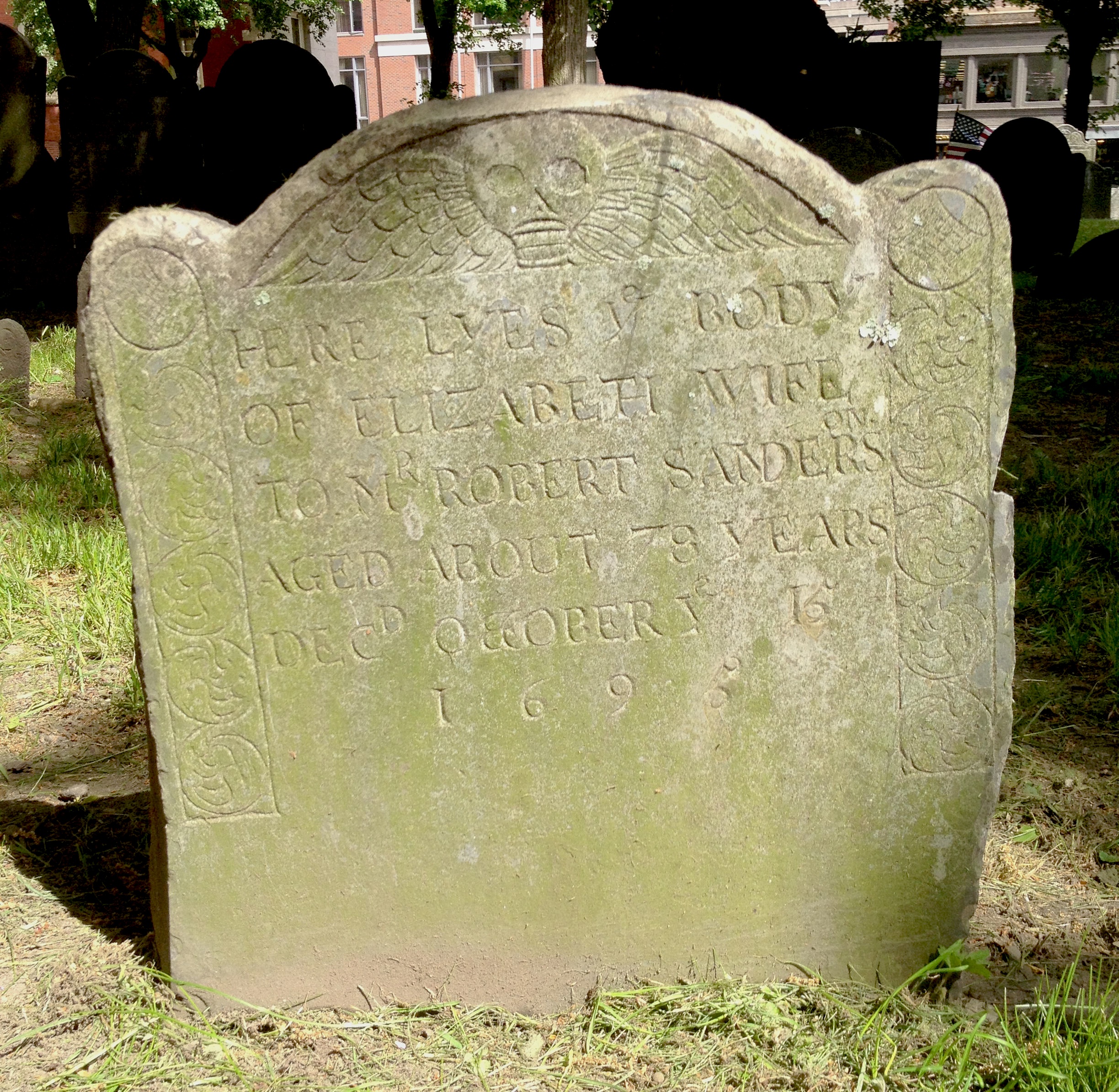
The grave of Robert's third wife, Elizabeth. Inscription: "Here Lyes Ye Body of Elizabeth Wife to Mr. Robert Sanderson Aged About 78 Years Dec'd October Ye 15 1695." The Granary Burying Ground, Boston, Suffolk County, Massachusetts. Plot: Location: G/C 579. |
|
| Personal Information |
Probate Record |
|
| Buyer: |
|
Sanderson, William |
| Seller: |
|
Joseph Parker |
| Town: |
|
Groton |
| County: |
|
Middlesex |
| State: |
|
Massachusetts |
| Date: |
|
18 Feb 1673 |
|
|
|
SOURCE INFORMATION: "Massachusetts Land Records, 1620-1986," (FamilySearch.org), Middlesex Deeds 1670-1678, vol 4-6, image 513 of 702; county courthouses and offices, Massachusetts.
|
|
By the 1670's, the English population of New England had increased to approximately 30,000, and there were approximately 90 towns or villages in Massachusetts, while the Indians/Native Americans were being pushed from their land. Colonists progressively encroached on the traditional territories of the several Algonquian-speaking tribes in the region, and tensions increased between tribes of Native Americans and the colonists.
Meanwhie, after raising a family in Watertown on or near the property of uncle Robert Sanderson, William relocated his family to Groton, a town northwest of Watertown and 40 miles from the Boston fort. William "Sanders" is recorded in the early records of Groton as one of the first 73 heads of families in Groton, and on 25 Nov 1670, town clerk John Morse recorded "uplands, sold to William Sanderson. Twenty acres, more or lesse," located "easterly by the towne high way." There is also deed for the sale of land from Joseph Parker and his wife Margaret of Groton to William in February of 1673 (pictured at left).
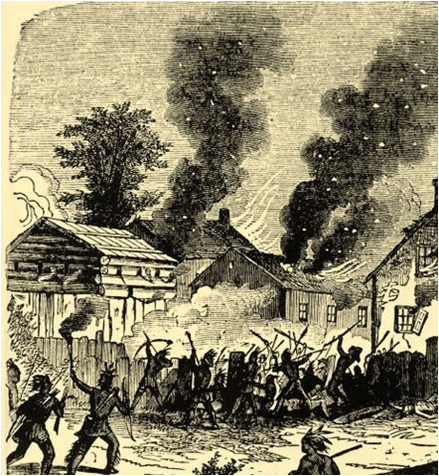
During King Philip's War (1675-1676), over half of the English towns were assaulted by Native Americans. This image is titled "Indian Raid in 1675" from the publication History of the town of Lancaster, Massachusetts: From the First Settlement, by Abijah Perkins and Marvin Thomas Sawyer. |
|
But hostilities between the Puritans and Native Americans increased, leading to King Philip's War, an armed conflict between Native American inhabitants and English colonists. In the space of little more than a year, twelve of the region's towns were destroyed and many more damaged, the colony's economy was all but ruined, and much of its population was killed, including one-tenth of all men available for military service. William saw the carnage first-hand on 13 Mar 1676, when the town of Groton was burned to the ground by Native American war parties. William and his family survived, and they relocated back to Watertown. With only a few isolated buildings remaining in the wilderness, Groton was abandoned until 1678, when the war ended and the settlers began returning to re-claim their land. But William was still in Watertown in 1689/90, when town records show his children "owning ye covenant" in which they pledge themselves to follow the covenant that the Congregationalists used to manage themselves and their relationship to God:
WATERTOWN CHURCH RECORDS, 1688-1689 |
| "Ye 8th of Aprill 1688 2 young Psons who owned ye covenant,viz William & Hannah Sanderson, ye children of William Sanderson." (SOURCE: Watertown Records: Comprising the Third Book of Town Proceedings and the Second Book of Births, Marriages, and Deaths to End of 1737; Also Plan and Register of Burials in Arlington Street Burying Ground. Watertown, MA: Fred G. Barker, 1900) |
| "Ye 20th of May 1688 3 children, a child of Samuell Jennisons called Lidia, & 2 of Sarah Sandersons (ye wife of William Sanderson)who owed ye Covenant, viz Joseph & Lidia" (Watertown Records, Volume IV Marriages) |
| "Ye 13th of January 1688/9 Mary Sanderson ye daughter of William Sanderson, she owned ye Covenant" (Watertown Records, Volume IV Marriages) |
|
| Personal Information |
Probate Record |
|
| Name: |
|
Sanderson, William |
| Town: |
|
Groton |
| County: |
|
Middlesex |
| State: |
|
Massachusetts |
| Death Date: |
|
27 Jul 1694 |
| Admin.: |
|
William Sanderson, Jr.; William Shattuck |
Case: |
|
19828 |
Call Number: |
|
F72/M7/M55 |
|
|
|
SOURCE INFORMATION: Middlesex County Probate Records, available on microfilm at the NEHGS Research Library.
|
Apparently, William then returned to his property in the rebuilt town of Groton (in fact, he's called "William Saunderson of Groton" in Robert's will of 1693). A "Wm. Sandors" was listed at a Groton town meeting on 24 Jun 1689. Then "William Sanders" was included as part of a ten man garrison in Groton, for protection against the Indians, on 17 Mar 1691/2.³ Hostilities were increasing again, and settlers began to flee the frontier for the safety of Watertown, Boston, and other better-protected settlements.
The government didn't like the idea of settlers giving land back to the native people, so on 12 Mar 1694-5, an Act was passed by the General Court, which prohibited the desertion by the inhabitants of frontier towns, including Groton, unless permission was first granted by the Governor and Council, on "pain of forfeiting their property." So William may stayed in Groton despite the danger, in order to protect his land. Garrisons were created, and William was stationed at the top northwest point with members of his family, under the command of Ensign John Lakin.
On Friday, July 27, 1694, Groton was attacked again by Abenaqui warriors. Their chief, Taxous, selected 40 of his best men and attacked the settlement at daybreak. 21 people were killed, and it was said that the scalps of 13 victims were presented by the victorious warriors to the Count de Frontenac, the governor of Canada. William Sanders(on) was among the dead. His probate record (at right) states that he "dyed by cruel heathen hands." William died without a will, but his estate was probated by his son, William Jr., and William Shattuck.
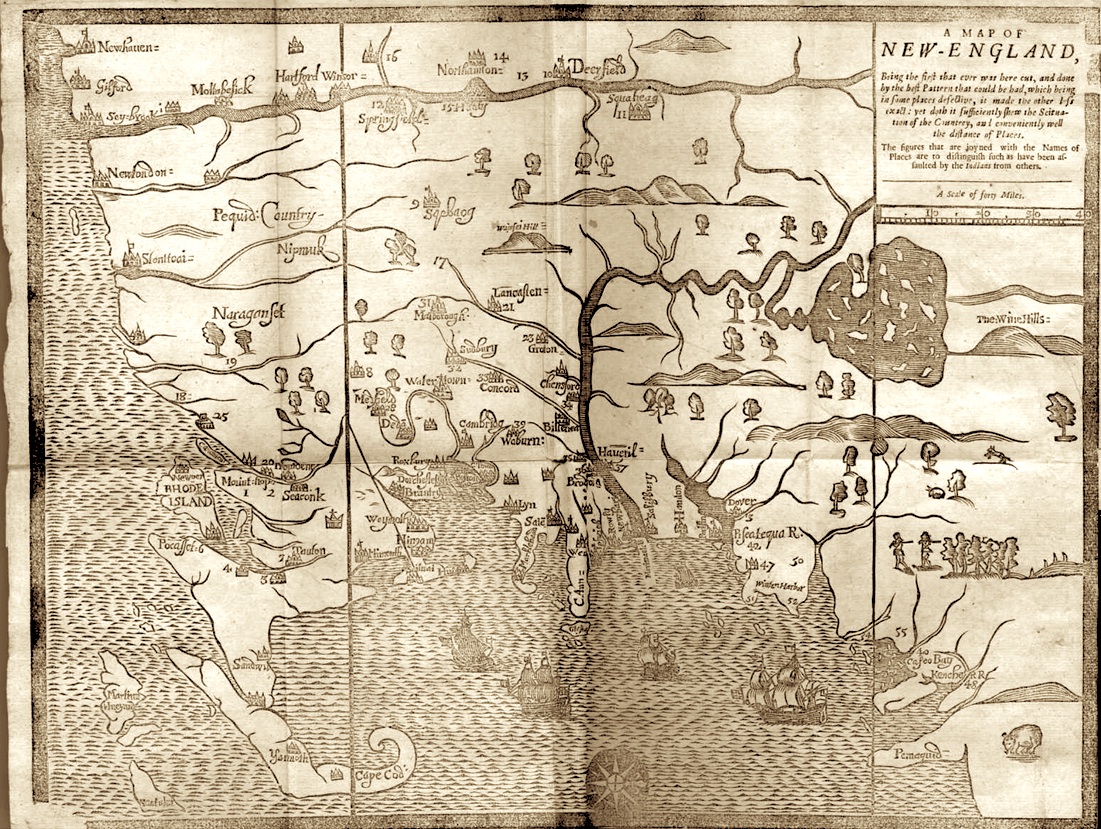
This map titled, "A Map of New England," was created by clergyman and historian William Hubbard (circa 1621-1704) for his book The History of the Indian Wars in New England. The book was published In London and Boston in 1677. |
WILLIAM SANDERSON, JR., born on the sixth of September in 1670, in Watertown. He was willed land by his uncle, Robert Sanderson, in the event of the death of Robert Sanderson, Jr. (However, Robert Jr. lived until 1714. Tough luck, William, Jr.) After his father's death, he remained in Watertown and married a woman named ABIGAIL TRAINE, but they apparently had no children. William then married a second time, to ANNA SHATTUCK in Watertown on May 4, 1703/4. She was from another prominent (and very large) family in town (Robert Sanderson mentioned a "kinsman" named William Shattuck in his will of 1693). Anna was the daughter of DR. PHILLIP SHATTUCK. (Dr. Phillip was a "physician of eminence and was chosen moderator of town meetings, held the office of assessor, town treasurer, chairman of the selectmen, and many other important stations of public trust.")
Fortunately, both the Sanderson and Shattuck families are well-chronicled during this period. According to Genealogies of the Families and Descendants of the Early Settlers of Watertown, Massachusetts, by Dr. Henry Bond (1860), and Memorial of the Descendants of William Shattuck, by Lemuel Shattuck (1855), Anna was born on the eighth of December, 1677, in Watertown, and died after 1740.
 |
|
| Personal Information |
Marriage License |
|
| Name: | | Sanderson, William & Anna Shattuck |
| Town: | | Watertown, Massachusetts |
| Date: | | May 4 |
Year: |
|
1704 |
|
|
|
SOURCE INFORMATION: Town and City Clerks of Massachusetts. Massachusetts Vital and Town Records. Provo, UT: Holbrook Research Institute (Jay and Delene Holbrook)
|
|
Anna and William lived in Watertown for about ten years, but the town was losing prominence (and would eventually be incorporated into the greater Boston area). Portions of Watertown were added to Cambridge on three occasions, and it also contributed territory to form the new towns of Weston, Waltham, Belmont, and Lincoln. By 1709, the Sanderson family had moved to nearby Sudbury, although William continued to work as a cordwainer (shoemaker) in Watertown through 1729 while son Amos performed the same craft in Sudbury. At that time, the boundaries of Sudbury included all of what is now Wayland, and parts of Framingham, Marlborough, Stow and Maynard. Sudbury was a frontier stronghold, and contributed the most militia men during King Philip's War.
William and Rebecca lived in Wayland, the first settlement of the Sudbury plantation, and had the following children:
CHILDREN OF WILLIAM SANDERSON AND ANNA SHATTUCK |
|
LYDIA SANDERSON was born on 17 Dec 1704, in Watertown, Middlesex, MA (click on the birth record, at right), according to Massachusetts, Town and Vital Records, 1620-1988 (Holbrook Research Institute). She married (1) Moses McIntosh (b. 1708), then on 28 Apr 1742 she married (2) James Maverick (1705-1750) in Sudbury, Middlesex, Massachusetts. Lydia died in 1754 in Sudbury, Middlesex, Massachusetts.
|
|
WILLIAM SANDERSON III was born on 10 Apr 1706, in Watertown, Middlesex MA. "Wm. Sanderson late of Shrewsbury, husbandsman" (farmer) died interstate on 18 Nov 1729 in Shrewsbury, Worcester, Massachusetts. "Father Will Sanderson, cordwainer (shoemaker) of Watertown, requests his son Amos Sanderson, Cordwainer of Sudbury, be appointed administrator of brother's estate." (Middlesex Co. Probate Record #19830, bondsmen Amos Sanderson of Sudbury and William White of Watertown). See report from BYU-Genealogical Research Center, at right.
|
|
AMOS SANDERSON was born on 07 Aug 1708, in Sudbury/Wayland, Middlesex, MA. He married Ruth Hoar (b. 1713) in Sudbury on 20 Apr 1732 and they had the following children: Abigail (1731-1821), William (b. 1735), Ruth (b. 1739) and Amos Sanderson II (1741-1767). Amos was a member of Member of First Foot Company of Sudbury, 25 Apr 1757. Amos died on 26 Jan 1763 in Sudbury, Massachusetts (click on the death record, at right), according to Massachusetts, Town and Vital Records, 1620-1988 (Holbrook Research Institute).
|
|
ANNA SANDERSON was born on 22 May 1709, in Sudbury/Wayland, Middlesex, Massachusetts (click on the birth record, at right), according to Massachusetts, Town and Vital Records, 1620-1988 (Holbrook Research Institute). On 04 Nov 1741, she married John Rice (23 Apr 1704 - 7 Dec 1771) in Sudbury, the son of Ephraim Rice and Hannah Livermore. They had the following children: Ann (b. 1743), Lydia (1744-1814), John (b. 1745), Jonas (1746-1778), Abraham (b. 1747), Amos (1749-1751), Lydia (1750-1835), Eunice (1751-1834), Lucy (1753-1782), Peter (1755-1813), Joel (1758-1838) and Nathan Rice (1760-1838)
|
|
DEBORAH SANDERSON was born on 14 Jan 1711, in Sudbury/Wayland, Middlesex, MA (click on the birth record, at right; this record also shows Amos and Anna), according to Massachusetts, Town and Vital Records, 1620-1988 (Holbrook Research Institute). She died in 1800.
|
|
ISAAC SANDERSON was born on 08 Oct 1714, in Sudbury/Wayland, Massachusetts (click on the birth record, at right), according to Massachusetts, Town and Vital Records, 1620-1988 (Holbrook Research Institute). On 24 Dec 1740, he married Keziah Bright (b. 27 Jul 1717), daughter of Henry Bright and Margaret Jackson, in Watertown, Middlesex, MA. Isaac died in 1777 in Watertown, Middlesex, Massachusetts.
|
OUR SANDERSON LINE
|
| Personal Information |
Wedding Banns |
|
| Name: | | Sanderson, William & Rebecca Morgan |
| Town: | | Springfield, Hampden, Massachusetts |
| Date: | | May 20 |
Year: |
|
1723/4 |
|
|
|
SOURCE INFORMATION: Town and City Clerks of Massachusetts. Massachusetts Vital and Town Records. Provo, UT: Holbrook Research Institute (Jay and Delene Holbrook)
|
|
Our first confirmed ancestor was WILLIAM SANDERSON (d. 5 Jul 1750), but we aren't sure when he was born, or which line listed above (if any) he belongs to. Springfield vital records show that William bought 7½ acres of land in Northfield, Hampshire (now Franklin) County, Massachusetts, at the junction of what are now the Massachusetts, New Hampshire and Vermont state borders along the Connecticut River, on 12 Aug 1718 (although the committee controlling the lands reserved the right to take its clay). Sanderson took possession of the land, but soon all of the clay was being dug up, and a brick-kiln set up in front of his property on the highway, which "rendered it an undesirable place of residence." If sinkholes and kiln smoke weren't enough of a hassle, they also enlisted William in the militia under Captain Partridge to fight local Native Americans, from 18 Aug to 26 Nov 1722.
Between the guerrilla warfare in the forest and his neighbors excavating the clay from his land and burning bricks on the highway, William had enough, and he removed fifty miles away to Springfield, in Hampden County. Springfield was founded in 1636 as the northernmost settlement of the Connecticut Colony. Purchases of large swaths of land from the Indians during the 17th century had enlarged Springfield's territory, and it had become the colony's most populous and important western settlement. In 1640, following a series of disputes, Springfield defected from the Connecticut Colony and joined the eastern, coastal Massachusetts Bay Colony.
William said he was from Brookfield, MA, when he posted banns to marry REBECCA MORGAN (20 Oct 1695 - 22 Feb 1775) on the 20th of May in 1723 in Springfield. (Banns are a legal requirement for Church of England weddings. Your intention to marry is announced by your minister on three Sundays in the three months before the wedding. They must be read in your parish church, as well as in the church where the ceremony is to take place.)
The Morgan family started in ancient Wales, and Rebecca was descended from two separate branches. The two family lines are responsible for many famous descendants (beyond us, I mean): Daniel Boone (his mother was a Morgan), Millard Fillmore, Morgan the Pirate, John Robbinson Jeffers, John Pierpont (J.P.) Morgan, General John Hunt Morgan, Archibald MacLeish, Humphrey Bogart, Thomas Lanier ("Tennessee") Williams, and more recently Princess Diana Spencer and her sons.
The Morgans were extremely prominent in Springfield, which gave William a much higher social standing than he had in Northfield. Rebecca's father, BURT JONATHAN MORGAN (16 Nov 1646 - 10 April 1714), grew up in Springfield and served in King Philip's War; he also participated in the Turner's Falls Fight under Capt. William Turner. Rebecca's grandfather, MILES MORGAN (1616 - 1699), was an adventurer, explorer, Indian fighter, constable, and local hero for his exploits during King Philip's War. A life-size statue of Captain Morgan is displayed in Court Square, Springfield. The colossal bronze artwork, sculpted by Jonathan Scott Hartley, shows Miles in huntsman's dress, jackboots, and cocked hat, with a rifle over his shoulder as he stands vigilant over the town, over 300 years after his death.
|
A statue of Rebecca Morgan Sanderson's grandfather, Miles Morgan, in Springfield, MA.
|

The Sandersons of Massachusetts continued to be great artists and craftsmen. Elijah and Jacob Sanderson were born in Watertown in 1751 and 1757, respectively, and became expert furniture makers. By 1779, they had moved to Salem and formed a partnership with Josiah Austin. The above desk, by Jacob Sanderson, is made of mahogany, with serpentine front and molded bracket feet... and you can't afford this, either. |
William and Rebecca raised a family in Springfield, near the rest of the Rebecca's family. In its early existence, Springfield flourished as both an agricultural settlement and trading post, although its prosperity waned dramatically during (and after) King Phillip's War in 1675, when Native American warriors laid siege to the settlement and burned it to the ground. The blockhouse of Rebecca's grandfather (seen, above) became the fortress of the place, and, after the burning of the settlement, held out until a friendly Indian sent by Miles carried word to Major Samuel Appleton at Hadley, who sent thirty-six men (the standing army of the colony of Massachusetts bay), as reinforcements. They arrived in time to save the lives of the besieged settlers. Sadly, among those killed was Peletiah, who would've been Rebecca's uncle. But the Morgans had stayed, rebuilt, and started over, and now William joined the alliance.
Now established in Springfield, William finally sold all of his land rights in Northfield to Henry Dwight of Hatfield on 29 Dec 1724. Then he and Rebecca had the following children:
CHILDREN OF WILLIAM SANDERSON AND REBECCA MORGAN
|
|
WILLIAM SANDERSON, JR., was born on 13 May 1724 in Springfield, Hampden, Massachusetts (click on the birth record, at right), according to Massachusetts, Town and Vital Records, 1620-1988 (Holbrook Research Institute). No further information.
|
|
MEDAD SANDERSON was born on 7 May 1726 in Springfield, Hampden, Massachusetts (click on the birth record, at right), according to Massachusetts, Town and Vital Records, 1620-1988 (Holbrook Research Institute). He married SARAH NICHOLSON on 7 May 1753, and they had the following children: Jeduthan (1755-1824), Hannah (1756-1792), Amaziah (b. 1760), Sarah (b. 1761), Medad (b. 1763), Charlotte (1764-1829), Sybil (b. 1766) and John Sanderson (1768-1773). Medad Sr. died on 11 Sep 1781.
|
|
REBECCA SANDERSON was born on 27 Jun 1728 in Springfield, Hampden, Massachusetts (click on the birth record, at right), according to Massachusetts, Town and Vital Records, 1620-1988 (Holbrook Research Institute). She married JAMES NASH on 25 Oct 1770 in Springfield. Rebecca died on 24 May 1815 in Springfield.
|
|
ELNATHAN SANDERSON Born: 03 Jul 1730, Springfield, Hampden, Massachusetts (click on the birth record, at right), according to Massachusetts, Town and Vital Records, 1620-1988 (Holbrook Research Institute).
|
|
AMAZIAH SANDERSON, b: 1 Sep 1732 in Springfield, Hampden, Massachusetts. He married ABIGAIL STEELE on 26 Jun 1751 in Springfield, Hampden, Massachusetts (click on the marriage record, at right), according to Massachusetts, Town and Vital Records, 1620-1988 (Holbrook Research Institute). She was the daughter of John Steele and Abigail Brookes. Amaziah died in 1757.
|
|
ROBERT SANDERSON was born on 13 Jul 1734 in Springfield, Hampden, Massachusetts, and was christened on 23 Jul 1734 (see image at right), according to Massachusetts, Town and Vital Records, 1620-1988 (Holbrook Research Institute). On 08 Mar 1754 he married RHODA STEELE (22 Jun 1735 - 7 Sep 1809), another daughter of John Steele and Abigail Brookes, in Springfield. They had thirteen children, listed below. They lived in Chester, Hampshire, Massachusetts during the first Federal Census, in 1790. Robert died in Aug 1798, in Chester, Hampden, MA.
|
|
| Personal Information |
Death Notice |
|
| Name: |
|
Sanderson, William |
| Town: |
|
Springfield, Hampden, Massachusetts |
| Date: |
|
July 6 |
Year: |
|
1750 |
|
|
|
SOURCE INFORMATION: Town and City Clerks of Massachusetts. Massachusetts Vital and Town Records. Provo, UT: Holbrook Research Institute (Jay and Delene Holbrook)
|
Neither William nor Rebecca lived to see the birth of a new nation, but Springfield was at the center of the revolution. During the 1770s, George Washington selected a high bluff in Springfield as the site of the U.S. National Armory, for its centrality to important American cities and resources, its easy access to the Connecticut River and because the city served as the nexus for well-traveled roads. During the War of Independence, the arsenal at Springfield provided supplies and equipment for the American forces. At that time, the arsenal stored muskets, cannons, and other weapons; it also produced paper cartridges. Barracks, shops, storehouses, and a magazine were built, but no arms were manufactured.
| Personal Information |
Birth Record |
| Name: | | Sanderson, Robert |
| Birth Place: | | Springfield, Mass. |
| Date: | | 23 Jul 1734 |
| Father name: | | Willm Sanderson |
| Mother name: | | Rebecah Sanderson |
|
|
|
| Personal Information |
Marriage Record |
| Name: | | Sanderson, Robert |
| Township: | | Springfield |
| State: | | Mass. |
| Spouse: | | Rhoda Steel |
| Date: | | 8 Mar 1754 |
| Page: | | 111 |
|
|
|
SOURCE INFORMATION: Town and City Clerks of Massachusetts. Massachusetts Vital and Town Records. Provo, UT: Holbrook Research Institute (Jay and Delene Holbrook)
|
The youngest son of William and Rebecca, ROBERT SANDERSON (23 Jul 1734 - Aug 1798) married RHODA STEELE (22 Jun 1735 - 7 Sep 1809) in Springfield, on 8 Mar 1754. They raised a family there, and were still registered in Springfield in 1775, and although Robert isn't listed on any musters, their sons Sylvanus and Tryall fought in the Massachusetts Militias.
After the revolution, an armed uprising in and around Springfield called Shays's Rebellion occurred during 1786 and 1787. Four thousand rebels (called Shaysites) protesting against perceived economic and civil rights injustices, marched on the United States' Armory at Springfield in an unsuccessful attempt to seize its weaponry and overthrow the government. The federal government found itself unable to finance troops to put down the rebellion, and it was consequently put down by the Massachusetts State militia as well as a privately-funded local militia.
We don't know which side Robert was on, but by the first Federal Census of 1790, he had moved his family out of Springfield to Chester, Hampden, Massachusetts, on the eastern edge of the Berkshire hills. The area had opened for settlement in the 1750s as Plantation (or Township) No. 9, and was chartered as Murrayfield on 31 Oct 1765. The town was incorporated as Chester on 21 Feb 1783, and Robert was registered there on 1 May 1788 (Source file: Massachusetts Vital and Town Records. Provo, UT: Holbrook Research Institute), as well as if the first Federal Census, two years later.
CHILDREN OF ROBERT SANDERSON AND RHODA STEELE |
|
SYLVANUS SANDERSON, b: 4 Oct 1754 in Chester, Hampden, Massachusetts. He fought as a private in the revolution (click on the pension ledger at right), according the the pension request of his wife, CHARLOTTE COOLEY, who he married on 13 Nov 1783, according to Massachusetts, Town and Vital Records, 1620-1988 (Holbrook Research Institute). They had the following children: Moses (b: 26 Jun 1784), Calvin (b: 23 Feb 1787), Samuel (b: 13 Jul 1789), John (b: 9 Feb 1790), David (b: 19 Oct 1791), Jonathan (b: ABT 1793), Harvey (b: ABT 1794), Mary Merrill (b: ABT 1795), Charlotte (b: ABT 1797), Julia (b: ABT 1799), Sally (b: 1802), Chauncy (b: 1808). Sylvanus died on 1 Mar 1834 in Chesterfield, Hampden, Massachusetts.
|
|
ELNATHAN SANDERSON was christened on 8 Feb 1756 in Springfield, Hampden, Massachusetts (click on the birth record, at right), according to Massachusetts, Town and Vital Records, 1620-1988 (Holbrook Research Institute).
|
|
RHODA SANDERSON was born on 14 Jun 1757 in Springfield, Hampden, Massachusetts (click on the birth record, at right), according to Massachusetts, Town and Vital Records, 1620-1988 (Holbrook Research Institute). She married SOLOMON FERRE (26 Sep 1752 - 8 Feb 1835) on 11 Jul 1776 in Springfield. They had the following children: Stephen (b. 8 Jul 1776); Rhoda (b. 29 Aug 1777); Solomon (20 Apr 1780 - 10 Apr 1833); Daniel (29 May 1782 - 1834); Lovina (b. 12 Sep 1784); Orreen (b. 6 Jul 1785); Horace (11 May 1790- 26 Nov 1865); Edmund (b. 15 Feb 1796); and Sophia Ferre (b. 13 May 1798). Rhoda died on 19 Oct 1830 in Springfield, Hampden, Massachusetts.
|
|
AZUBAH (RUBIA) SANDERSON was christened on 25 Mar 1759 in Springfield, Hampden, Massachusetts. Azubah married JOHN SHEPERD (1727 - 1784) on 20 May 1779 (click on the marriage record, at right), according to Massachusetts, Town and Vital Records, 1620-1988 (Holbrook Research Institute), but Azubah then died on 22 Aug 1779.
|
|
MARY SANDERSON was born on 13 Feb 1761 in Springfield, Hampden, Massachusetts (click on the birth record, at right), according to Massachusetts, Town and Vital Records, 1620-1988 (Holbrook Research Institute). Mary died as an infant in 1762.
|
|
TRYALL SANDERSON was christened on 29 Aug 1762 in Springfield, Hampden, Massachusetts. He served as a private in Burt's Company, Guards, of the Massachusetts militia during the Revolution (click on Revolutionary War Service Record, at right), then married ELIZABETH SMITH (1741 - 1790) on 30 Apr 1785, according to Massachusetts, Town and Vital Records, 1620-1988 (Holbrook Research Institute). Tryall died on 25 Jul 1785.
|
|
ACHSAH SANDERSON was christened on 26 Aug 1764 in Springfield, Hampden, Massachusetts. She married JAMES WARNER (28 Mar 1765 - 1798) on 28 Apr 1789 in Springfield (click on the marriage record, at right), according to Massachusetts, Town and Vital Records, 1620-1988 (Holbrook Research Institute). They had the following children: Henry (15 May 1789 - 11 Apr 1838), Dorcas, James and Rebecca. Achsah died in 1806.
|
|
TIRZAH SANDERSON was born on 29 Mar 1767 in Springfield, Hampden, Massachusetts (click on the birth record, at right), according to Massachusetts, Town and Vital Records, 1620-1988 (Holbrook Research Institute). She married LEWIS HANCOCK (9 May 1767 - 1791) on 2 Mar 1786 in Springfield. They had the following children: Sophia (1800- 1 Apr 1866) and Loren D. (5 Sep 1813 - 30 Nov 1898). Tirzah died in 1810.
|
|
SUBMIT SANDERSON was born on 27 Jun 1769 in Springfield, Hampden, Massachusetts (click on the birth record, at right), according to Massachusetts, Town and Vital Records, 1620-1988 (Holbrook Research Institute). She married HEMAN (sic) PRIOR (7 Aug 1769 - 1813) on 20 Sep 1789 in Springfield, Hampden, Massachusetts. They had the following children: Heman (21 May 1790 - 1850); Levi (28 Feb 1794 - 1795); Rhoda (1799 - 1800); Ebenezer (1801 - 1802); Robert (1805 - 20 Feb 1875); Luther (1807 - 1808); Phillip (1809 - 1810); Leonord (22 Apr 1811 - 6 Feb 1878). Submit died in 1813.
|
|
ELIJAH SANDERSON was christened on 10 May 1772 in Springfield, Hampden, Massachusetts (click on the birth record, at right), according to Massachusetts, Town and Vital Records, 1620-1988 (Holbrook Research Institute). He married Saloma Babcock (18 Jul 1775 - 1800) on 19 Oct 1795. They had the following children: Elisha Sanderson (4 Jan 1803 - 19 May 1865); Saloma (17 Sep 1806 - 25 Dec 1859). Elijah died in 1850 in Jackson, Indiana.
|
| THANKFULL SANDERSON was christened on 11 Jul 1773 Springfield, Hampden, Massachusetts. On 2 Oct 1791 she married Jonathan Bolton in Blandford, Hampden, Massachusetts. They had the following children: Thankful (1792-1844), Rachel (1795-1856), Sally (b. 1797), James Sanderson (1802-1855), Rhoda Steele (1803-1874), David (1807-1865), and Polly Bolton (b. 1815). Thankful died on 10 Oct 1850 in Hancock, Delaware, New York. |
|
ELNATHAN SANDERSON was born on 29 Dec 1777 in Springfield, Hampden, Massachusetts, and christened on 5 Jan 1778, according to Massachusetts, Town and Vital Records, 1620-1988 (Holbrook Research Institute). On 12 Feb 1801, he married Betsey Waters in Chester, Hampden County, Massachusetts (click on the marriage record, at right), according to Massachusetts, Town and Vital Records, 1620-1988 (Holbrook Research Institute). Family listed below. Elnathan moved to New York in 1806, and died on 29 Nov 1854 (best reading of his gravestone), "aged 78y." He is buried in the Quaker Cemetery, Philadelphia, Jefferson County, NY. (Gravestone photo courtesy of NNYGenealogy.com.)
|
| CHARITY SANDERSON was christened on 4 Apr 1779 in Springfield, Hampden, Massachusetts. She died a year later, in 1780. |
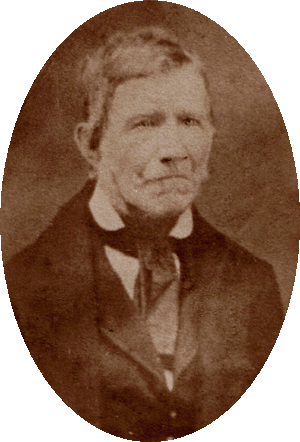
| Elnathan Sanderson (1777-1854) |
|
Robert and Rhoda finally quit after 13 kids, probably because they had run out of names after "Submit," "Thankful" and "Charity." They even used one name twice, to name our ancestor, ELNATHAN SANDERSON (1777 - 1854). At this time, a child was often named after a deceased sibling as a tribute. There is no record of the death of the first Elnathan, nor really ANY kind of record, but we know he was born to Robert and Rhoda in late 1755 or early 1756. This means he could have died in infancy, like a large percentage of children in that rough time, but it seems unlikely that Robert would wait twenty years to honor his name with another child. But Elnathan I would have been about 21 years old at the time of the American Revolution, a year before Elnathan II was born, and Massachusetts was the flashpoint at the start of the war, so he could have died in battle.⁴
Whatever happened, the second Elnathan, our ancestor, was born and named in 1777. He was Christened on the 5th of January, 1778. According to Past and Present of MACOMB COUNTY, MICHIGAN, by Robert F. Eldredge, "Elnathan Sanderson ... was born in Massachusetts in the year which gave birth to the American republic—the year in which the Declaration of Independence was signed. He was the youngest in a family of fourteen children and in 1806 he removed from the old Bay state to New York, settling in Herkimer county." (Page 258)⁵
| Personal Information |
Census Image |
| Name: | | Sanderson, Robert |
| Township: | | Chester |
| County: | | Hampshire |
| State: | | Mass. |
| Year: | | 1790 |
| Roll: | | M637_4 |
| Page: | | 105 |
| Image: | | 0161 |
Slaves: |
|
0 |
|
|
|
| Personal Information |
Census Image |
| Name: | | Sanderson, Elnathan |
| Township: | | Chester |
| County: | | Hampshire |
| State: | | Mass. |
| Year: | | 1800 |
| Roll: | | M32_15 |
| Page: | | 1122 |
| Image: | | 148 |
Slaves: |
|
0 |
|
|
|
SOURCE INFORMATION: 1790 & 1800 US Census Records. Index created from United States of America, Bureau of the Census.
|
In 1790, Elnathan was still living with Robert, the only male out of three listed in the census who was under the age of 16, along with two females. But by the time of the 1800 census, Elnathan was the only male remaining in the house, living with one woman over the age of 45 (presumably his widowed mother).
According to a Hause Family Bible in the possession of Jerry Hause in Michigan, created by Melissa Sanderson-Hause (the granddaughter of Elnathan), he then married a woman named BETSEY WATERS, on February 12, 1801 in Chester, Hampden County, Massachusetts. (Her name is spelled "WALTERS" by some genealogical sources, but WATERS here: Family History Library, Salt Lake City, UT, Film # 0760646 & 0879889, and in the book, Vital Records of Chester, Massachusetts, to the Year 1850, published in 1911)
Elnathan and Betsy had nine children:
CHILDREN OF ELNATHAN SANDERSON AND BETSEY WATERS
|
|
BETSY SANDERSON, was born in 1802 in Chester, Hampden, Massachusetts, according to Massachusetts, Town and Vital Records, 1620-1988 (Holbrook Research Institute; See her birth notice, at right.) In 1860, she was living with her brother Sherman and his family in Conneaut, Crawford, Pennsylvania. Betsy died in Mar 1870 from consumption in Conneaut, Crawford, Pennsylvania, according to an 1870 Federal Census Mortality Schedule (see image here; National Archives and Records Administration (NARA); Washington, D.C.; Non-Population Census Schedules for Pennsylvania, 1850-1880: Mortality; Archive Collection: M1838; Archive Roll Number: 5; Census Year: 1870; Census Place: Conneaut, Crawford, Pennsylvania; Page: 1.)
|
|
DAVID SANDERSON was born on 28 Apr 1804 in Chester, Hampden, Massachusetts, according to Massachusetts, Town and Vital Records, 1620-1988, by Holbrook Research Institute. In the early teens of the 19th Century his family moved to New York, where he married POLLY BRIGGS in Russia, Herkimer County, New York, in 1831. They moved to Ohio, then in the early 1850's he moved to Riley Center, Michigan. Polly died on November 7, 1867, and David passed away on January 24, 1884, "Aged 79 Y's, 8 M's 4 D's." He's buried at the Memphis Cemetery in Memphis, Macomb County, Michigan.
|
|
JULIA ANN SANDERSON was born in November of 1806. In the 1854 will of her father, she is named as the wife of WILLIAM ALLEN (1799-1888) of Antwerp, Jefferson Co., New York.⁶ They had the following children: Alfred A. ( 1830-1898), George Washington (1832-1873), Stephen (1834-1867), Harriet L (1839-1895), and William B Allen (1848-1868). Julia Ann died on 8 Jun 1885 in Antwerp, Jefferson, New York, and is buried at Hillside Cemetery in Antwerp, Jefferson County, New York.
|
 |
EDWARD WATERS SANDERSON was born in 1809 in New York. In the 1830's he traveled to Bainbridge Township, Gauga County, Ohio, along with his brother, David (they were neighbors in the 1840 and 1850 census), where they did farmwork. On 8 Oct 1834, he married NANCY JENNET TREAT (b. 1811 in Herkimer Co., NY, according to the Meadville, PA Tribune Republican Centennial Edition, May 12 1888). She was the great, great granddaughter of Capt Robert Treat, (early) Govenor of Connecticutt. In 1854 the family moved to Conneaut, Crawford, Pennsylvania. Children: Eliza Cordelia (b. 18 Aug 1836, m. Henry Abner Greenfield on 2 Sep 1860), William Edward, carriage maker and Civil War veteran (b. 1 Mar 1841), Sarah Treat (b. 10 Oct 1844, m. Civil War vet William Russell Greenfield on 1 Jan 1866), and twins Henry (b. 14 Feb 1847, m. Sarah Jane Penfield 13 Oct 1869) and Henrietta (b. 14 Feb 1847; m. Cornelius Brooks 8 Sep 1880; d. 3 Jun 1888). Edward died on 9 Oct 1876. In 1880, Nancy was still in Pennsylvania, living next to Henry, and listed as a widow with William E. and Henrietta. She was still there at age 90 in 1900, with William farming the property and Henry's daughter, Nellie, tending the house. Image at right: Bio of son W.E., in History Of Crawford County, Pennsylvania, Volume II. Chicago: Warner, Beers & Co., 1885. P. 836.
|
|
MARVIN SANDERSON was born in 1811. He moved to Geauga, Ohio with his brothers and died there in 1850; His probate is dated 3 Apr 1850 , with brother Edward W Sanderson serving as administrator. (Probate File Case Number: S-784)
|
 |
SHERMAN STEPHANSON SANDERSON was born in 1814 in New York, according to the 1850 Cenus, which shows him employed as a farmer, living near his brothers in Russell, Geauga, Ohio, with his wife, 30 year-old AURILLA (1810-1835). They had been issued a marriage license on 25 Dec 1840 in Ohio. They have one child in the census, 5 year-old daughter Alice. Their son Charles S. was born @ 1853. Geauga County then lists Sherman as marrying Lovina Green (1826-1901) on 04 May 1856. Both marriages were in Russell Township. By 1860 they had moved to Conneaut, Crawford, Pennsylvania, and had a daughter, Emma (b. 1862) and a son, James (1866 - 3 Dec 1907). Sherman moved to Michigan near his brother, David. His fine home still sits high on the terrace of the hill on the north side of Bordman Road in Memphis. Sherman began a cheese making factory in Memphis in 1870. The factory buildings were located in the valley on the north side of Bordman Road, east of town. The first Sanderson house was located in the valley, north of the factory buildings. The cheese making operation became very substantial and operated throughout the 1870s. The Romeo Observer newspaper reported in the late fall of 1873 that "The Memphis cheese factory has closed for the winter after having produced about fifty tons of cheese this year." During the early 1880s the cheese business was no longer as profitable; the factory was reduced. In 1884 one of the single story factory buildings was moved from the valley, up onto the terrace on the hill and remodeled to become the new Sanderson home. In 1887, Sanderson added a 2 story addition onto his home, shown here in this 1930s photo. The Sandersons then began mining sand and gravel from the hill side to the west of the valley, as shown in this photo. Sherman Sanderson died in 1894 and his wife, Lovina, in 1901. The property was inherited by their daughter-in-law, Helena L. Sanderson. The Sanderson family continued the gravel business until Helena died in 1944. Nick Bardas purchased the property (including the home) from the estate and continued the gravel business until 1968, when he sold all to Harry and Jeanice Raymond. Sherman is buried at Fisher Cemetery in Novelty, Geauga, Ohio. (Thanks to Tom Cairns of Memphis for the photos and info.)
|
 |
DELANA "DENLANY" SANDERSON was born in 15 Feb 1817 in Herkimer Co., New York. She married MORGAN LEWIS FENNER (1813-1902) in 1839,⁷ and had the following children: Edwin Seth (1842-1921); James Elroy (1844-1912); Freelove (1847-1916); Augustus Morgan (1851-1929); and Olivia Fenner (1858-1862). She died on 11 Apr 1892 and is buried at Linesville Cemetery in Linesville, Crawford County, Pennsylvania. From the 16 Sep 1902 issue of The Linesville Herald: "Morgan L. Fenner, the oldest person in Linesville, died at his residence September 9th, 1902, in the 90th year of his age. He had been in good health until about two weeks ago, when he began to fail and gradually grew weaker until the time of his death. He had no particular disease, the cause of his death as stated by himself, was 'he was worn out.' His daughter, Mrs. H.A. Penfield, and family, have resided with him for a considerable time. He was born in Cold Brook, Herkimer county, N.Y., Feb. 22, 1813, and was the survivor of a family of seven children of which he was the second son. He resided in Herkimer county until 1849, when he moved with his family to Conneaut township, this county, where he resided until 1872, when he located in Linesville, where he has since remained. In 1839 he was married to Delany Sanderson, of Herkimer county, N.Y., who died April 11, 1892; to them five children were born, viz: E.S. Fenner, of Franklin, Pa.; Olevia, who died in infancy, in 1862; J.E. Fenner, Mrs. H.A. Penfield and A.M. Fenner, of Linesville. Religiously Mr. Fenner was a Spiritualist; politically, he was a Republican, and voted the Republican ticket straight, at every election, from the time he voted for John C. Fremont, in 1856, until the time of his death. He was very energetic, industrious and a fine mechanic - by trade, a millwright; In the earlier part of his life he was extensively engaged in grist and saw mill building and farming. In a general way he was a very successful business man." They are buried at Linesville Cemetery in Linesville, Crawford County, Pennsylvania, USA; Plot: Section A, Lot 5, Grave 5.
|
| AMANDA SANDERSON was born on 29 Nov 1820 in Russia, Herkimer, NY. The 1854 will of her father lists her as the wife of JEREMIAH SMITH (1805 - 26 Apr 1880) of Antwerp, Jefferson, NY.⁶ They raised the following children: Almon Beecher (1842-1916), Emma E (b. 1845), Harriet C (b. 1848) and Nancy D Smith (b. 1852) in Antwerp until the death of her father, then moved 80 miles east, back to where she was raised in Russia, Herkimer, NY. Amanda passed away on 12 Feb 1872 and is buried at Gravesville Cemetery in Gravesville, Herkimer County, New York. |
| SILVIA JANETT SANDERSON was born in 1822 in New York. She married ELIPHALET CHENEY (1819-1885) and had two children: ERVIN FRANKLIN CHENEY (1944-1922) Quartermaster Sergeant of the Civil War: H83, Pa Infantry, B21 New York Cavalry; ELNATHAN SANDERSON CHENEY (1847-1934) US Civil War: Union Troop F, 2nd Pa Cavalry, from 2/20/1864 to 7/13/65; CHARLES S CHENEY (1855-1856), and GEORGE E CHENNEY (1857-1882). Sylvia died on 27 Oct 1865 in Darien, Genesee, New York. |
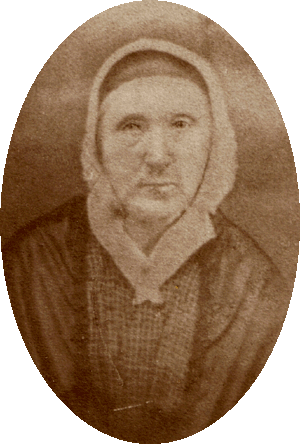
|
The Sandersons moved to Russia township, Herkimer county, New York, around 1810. The town had been formed from the town of Norway on 7 Apr 1806, but then on 6 Apr 1808, it was changed to the town of Russia. (According to the Herkimer County Historian, records fail to reveal why the name was selected.) The town sat on the west border of Herkimer County, north of the Mohawk Valley. Despite the Eastern European name, there are no records of white settlers in Russia township prior to the Revolutionary War. The life could not have been easy. An 1824 Gazetteer of the State of New York, by Horatio Gates Spafford, described the township as "being about 40 miles long N. and S., and about 16 wide. But the settlements are confined to 7 or 8 miles of the S. end, or rather a narrow strip along W. Canada creek, at the SW. corner of the town. The northern part is clothed with impenetrable forests of spruce, fir, larch, and some pine, and the soil is as forbidding as its forest woods would indicate. Yet there are tracts of arable land, on which farmers might get a poor living; but the general character of the land is very uninviting." The family remained in Herkimer County for the next few decades, but Elnathan's sons would eventually move west, to more inviting lands in the frontiers of Ohio.
There were other changes, as well. We don't know when or how, as records are scarce, but at some point between 1820 and 1825, Betsy disappears from the record.⁷ The name of Elnathan's wife changes from Betsey to "Pruelly" or "Pruella" by 1830. (Wives' names weren't listed on the Federal Census until 1850, when the children were all grown and Betsey would've been in her sixties, so those records don't help.) The Sanderson family included nine children who grew to adulthood (although some may have been stepchildren from the second marriage). In the early nineteenth century, family sizes were large and the typical American woman had between seven and eight live births in her lifetime, while people probably lived fewer than forty years on average. A woman's chances of dying during childbirth on the frontier were between one and two percent—for each birth. So if a woman gave birth to multiple children like Betsey, her chances of eventually dying in childbirth were pretty high. In the 1825 State Census, there were five males and five females in the "Saunderson" household, but three of the females were under 16, and all five were single. This suggests that Betsey died sometime between the censuses in 1820 and 1825. "Pruelly" is the name listed in Elnathan's 1852 Will along with his children. She's listed again in the 1865 New York State Census, as "Prually Sanderson," a 76 year-old widow, married only once and living by herself with Columbia, New York, as her birthplace (Philadelphia, Jefferson, New York, page 43, line 27). In the 1870 census she's back in Russia, Herkimer, New York, 82 years old and living with daughter Amanda Sanderson Smith's family.
|
| Personal Information |
Census Image |
|
| Name: | | Sanderson, Elnathan |
| Township: | | Russia |
| County: | | Herkimer |
| State: | | New York |
| Year: | | 1810 |
| Roll: | | M252_27 |
| Page: | | 403 |
| Image: | | 223.00 |
M-10: | | 2 |
M, 26-45: | | 1 |
F-10: | | 2 |
F, 26-45: | | 1 |
|
|
|
|
|
| Personal Information |
Census Image |
|
| Name: | | Sanderson, Elnathan |
| Township: | | Russia |
| County: | | Herkimer |
| State: | | New York |
| Year: | | 1820 |
| Roll_Page: | | 67_44 |
| M, 1-10: | | 2 |
| M, 16-26: | | 1 |
| M, 26-45: | | 1 |
| F, 1-16: | | 3 |
| F, 16-26: | | 1 |
| F, 26-45: | | 1 |
|
|
|
|
|
| Personal Info |
Census Image
|
|
| Name: |
|
Sanderson, Elnathan |
| Township: |
|
Russia |
| County: |
|
Herkimer |
| State: |
|
New York |
| Year: |
|
1830 |
| Roll_Page: |
|
91_29 |
| M, 15-20: |
|
2 |
| M, 50-60: |
|
1 |
| F, 5-10: |
|
1 |
| F, 10-15: |
|
2 |
| F, 20-30: |
|
1 |
| F, 40-50: |
|
1 |
|
|
|
|
| Personal Info |
Census Image |
|
| Name: | | Sanderson, Elnathan |
| Township: | | Philadelphia |
| County: | | Jefferson |
| State: | | New York |
| Year: | | 1840 |
| Roll_Page: | | 291_56 |
| M, 60-70: | | 1 |
| F, 30-40: | | 1 |
| F, 40-50: | | 1 |
| F, 60-70: | | 1 |
| | |
| | |
|
|
|
|
SOURCE INFORMATION: United States Federal Census. National Archives and Records Administration, Washington DC.
|

David Sanderson (1804-1884), tintype from the Family Bible of Jerry Hause |
DAVID SANDERSON was born on 28 Apr 1804 in Chester, Hampshire, Massachusetts, a few years before the family relocated to New York. While living with his family in Herkimer County, he met POLLY BRIGGS (1811 - 1867), the daughter of another Massachusetts transplant named LEMUEL BRIGGS, in a line descended from a famous Minuteman who fought at the battle of Bunker Hill. The Briggs family now lived in the same New York township as the Sandersons (they appear two pages later in the 1830 census). And in 1831, David married Polly.
David and Polly had their first son, whom they named Edward, after David's younger brother, in New York. But by the 1830s, the best farmlands in New York had long since been sold off and cultivated, even in the unforgiving agricultural region around Russia township; and since most of the remaining Native American land had been divided up to veterans after the Revolution and War of 1812, there was little new land to start a family on. So the family family soon moved on from that state, in pursuit of more plentiful (and cheaper) land, in the rapidly expanding west.
So David and Polly eventually settled in Bainbridge Township, Geauga County, in northeast Ohio, along with David's brothers, Edward, Marvin and Sherman, sometime in the early 1830's (David and Edward were neighbors in the 1840 census).
Geauga County was founded on March 1, 1806 as the second county in the Connecticut Western Reserve, originating from Trumbull County, Ohio. Geauga County is named after the Onondaga word jyo'ä-gak or Seneca jo'ä-ka, both meaning 'raccoon' (originally the name of the Grand River). Despite the name, a dearth of Native American activity in Geauga meant that there was no need for settlers to cluster near a fort for protection, and pioneers spread over the landscape in the early 1800s. The sand ridges and rivers became highways for the westward pioneers like the Sanderson brothers, seeking land in the Connecticut/Ohio Western Reserve, of which Geauga was a part. They packed their wagons and followed the Lake Trail west, along the muddy, bumpy ridges of the ancient lakeshore or the Forbes Road through Pennsylvania, heading for a place described as a land of milk and honey in the 1803 Hartford Courant.
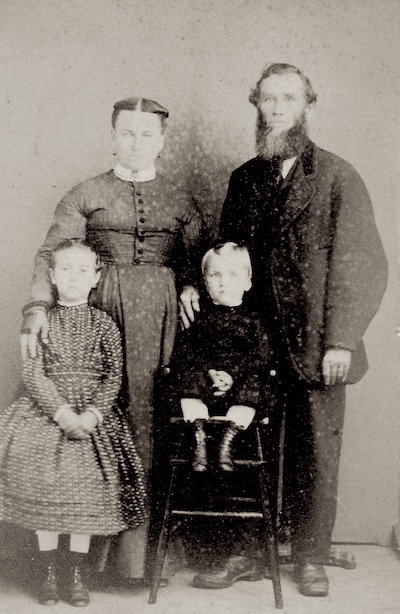
A carte de visite taken in Chagrin Falls, Ohio, probably of Sherman S Sanderson (1814-1894), wife Lovina (1826-1901), and their last two children, Emma (1862-1907) and James (1866-1907).
|
|
Bainbridge Township was established in 1817, named for a well-known naval hero of the War of 1812, Commodore William Bainbridge. In 1820 the census count was 199, and in the next thirty years the population rose to 1,014. Commercial endeavors flourished in Bainbridge. A number of the plants were located along Crackel Road, creating Centerville Mills. Chillicothe Road in Bainbridge Center also thrived with an assortment of blacksmith shops, sawmill, cheese box factory, and various stores.
David apparently worked as a yeoman, and would have to work his way up from the bottom to buy land and start his own farm. By 1849, Ohio farmers produced more corn than any other state, and ranked second in wheat production. Numerous Ohioans also planted orchards from seeds that they brought with them to the region. John Chapman, also known as Johnny Appleseed, played an important role in developing apple orchards in Ohio. Due to the climate, apples and peaches were especially easy to grow and became quite popular. Strawberries and Catawba grapes also grew well. Ohio farmers also raised livestock, most importantly cattle, sheep, and pigs. While all of these animals served as food sources for Ohioans, sheep also provided their wool to textile factories, one of which flourished in Bainbridge. There were also five cheese factories, a trade that each of the brothers would try their hands at in the coming decades.
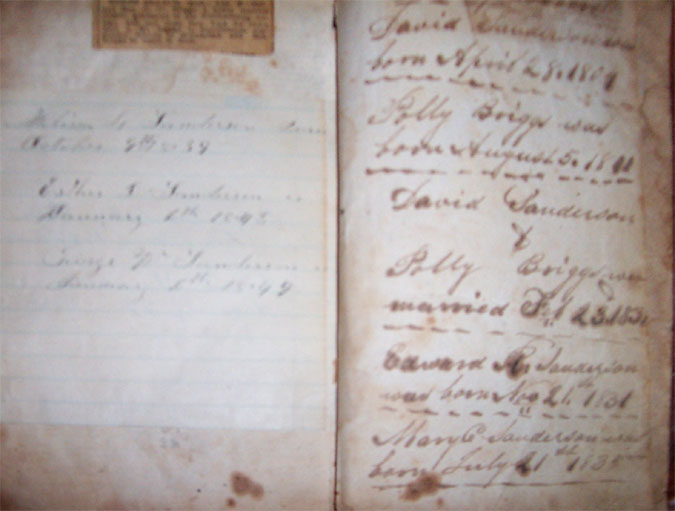
A sample page from a Sanderson family genealogy, in possession of Jerry Hause of Michigan.
|
|
| Personal Information |
Census Image |
|
| Name: | | Sanderson, David |
| Township: | | Bainbridge |
| County: | | Geauga |
| State: | | Ohio |
| Roll: | | 339 |
| Page: | | 345 |
Year: | | 1840 |
|
|
|
SOURCE INFORMATION: United States Federal Census. National Archives and Records Administration, Washington DC
|
By 1850, Edward had become a land owner, but David, Marvin and Sherman were apparently still farm hands with no real estate to claim in the census. In 1850, Marvin died with barely any money to his name, once his debts were paid by Edward, the administrator of his probate. The remaining three brothers parted ways, with David moving north across Lake Erie, to the new state of Michigan. Around 1854, at the time of their father Elnathan's death in Philadelphia, Jefferson, New York, Edward and Sherman went back east to Conneautville, Pennsylvania, near the family of their sister Sylvia Sanderson Cheney, who were prominent residents.
David and Polly's family settled in Riley Center, Michigan, sometime before 1855. David's brother, Sherman Sanderson, would follow later with his family. (Apparently his venture with their brother Edward in Pennsylvania hadn't worked out, so he reunited with David.)
Michigan had only been a state for about twenty years, and there was plenty of new land to acquire. David bought a nice piece of real estate, building a farm worth $4000 by 1860, and had a personal estate of $1879, as well. In 1876, David & Edward Sanderson (his son) had separate but adjoining acreage, west of the Belle River. By the 1880 census, the value of the property had more than doubled. Here's another account:
| Past and Present of MACOMB COUNTY, MICHIGAN, by Robert F. Eldredge, together with Biographical Sketches of it's Leading and Prominent Citizens and Illustrious Dead. Chicago: The S. J. CLARKE Publishing Co. 1905 (p.268) David Sanderson... was born in Massachusetts, was reared in Herkimer county, New York, and when he had reached man's estate was married to Miss Polly Briggs, who was born in New York, August 6, 1811. He then devoted his attention to agricultural pursuits in Herkimer county for a number of years, while later he removed to Geauga county, Ohio, arriving there in May, 1834. He followed farming in that locality for a number of years and then removed to Michigan in 1850. The following year he located just across the boundary line of Macomb county in St. Clair county, where he purchased wild land that was covered in a dense growth of timber. This he had to clear away before he could plant crops, but his persistent efforts soon wrought a transformation in the place, and where once was seen tall trees there were later found fields of waving grain.⁸
|
| Personal Information |
Census Image |
| Name: | | David Sanderson |
| Age: | | 45 |
| Birthplace: | | NY |
| Home in 1850: | | Banebridge Township Gauga County, Ohio |
| Gender: | | Male |
| Estimated Birth Year: | | 1804 |
| Birth State | | New York |
| Family (on next page) | | Click here |
| Page: | | 302 |
| Roll: | | M432_603 |
| Year: | | 1850 |
|
|
|
| Personal Information |
Census Image |
| Name: | | David Sanderson |
| Age: | | 56 |
| Birthplace: | | Mass. |
| Home in 1860: | | Riley, St Clair County, Michigan |
| Estimated Birth Year: | | 1804 |
| Post Office: | | Memphis |
| Roll: | | M653_559 |
| Value of Real Estate: | | 4000 |
| Value of Personal Estate: | | 1879 |
| Year: | | 1860 |
|
|
|
SOURCE INFORMATION: 1850 and 1860 United States Federal Census. National Archives and Records Administration, Washington DC
|
In the 1860 Census, there are two boarders in the David Sanderson house: James and Juliette "Pinkman" (or Pincombe), brother and sister aged 27 and 23 respectively. They became more than just boarders, however! James married David's daughter, Mary Sanderson. David and Polly had five children, in all:
CHILDREN OF DAVID SANDERSON AND POLLY BRIGGS |
|
EDWARD R. SANDERSON was born on 21 Nov 1831 in Russia, Herkimer, New York. He was living with his parents in 1850 at age 19, but appears on his own in the 1860 Census. He served in the Michigan Infantry during the Civil War until he was honorably discharged on 6 Sep 1865. Edward married JULIA EDGETT (20 Mar 1837 - 10 Aug 1927) and in the 1880 census they were raising his brother George's daughter, ORPHA SANDERSON, after the death of her mother, Mary Almina Simpson-Sanderson. Edward died on 14 Feb 1907 in Romeo, Macomb, Michigan. He and Julia are buried at Romeo Cemetery, Romeo, Macomb County, Michigan.⁸)
|
|
MARY CORDILIA SANDERSON was born on 21 Jul 1835 in Ohio. Around 1860, she married JAMES PINCOMBE (1833 - 1912). He was a stone and brick mason, a trade he learned from his father. In 1865, 32-year-old James enlisted for service of 1 yr in the Union Army. He was assigned to Co. B, 29th Regiment, then transferred to Co B 22nd Regiment. Mary died on 22 Feb 1903 in Riley, St Clair, Michigan, United States.
Click photo at right to access the Pincombe family Genealogy.
|
|
MELISSA SANDERSON was born on 09 Oct 1839 in Bainbridge, Cuyahoga Co., Ohio. She became a schoolteacher in Memphis, Michigan, at age 15. She then married the family's neighbor, LABAN HAUSE. They had four children, Alice, Sarah, Frank and Edith, listed below. Melissa died in Memphis, St. Clair Co., Michigan, on 25 Nov 1921 and is buried at the Memphis Cemetery in Memphis, Macomb County, Michigan.
Read a Hause genealogy by Melissa here.
Read a letter written by Melissa to her grandson Ray here.
|
 |
ESTHER D. SANDERSON was born on January 6, 1842, in Ohio. At the age of 19, she married ALLEN LUSK, 24, of Riley, on 17 Dec 1862. Laban "Haws" & James Picombe were witnesses, and William T. Russell, Minister. She then married a man named ALFRED PURDY (born 1838 in Canada), a farmer. In 1870, they lived in Riley, St. Clair Co., with their 2-year-old daughter, EMMA E. PURDY (15 Sep 1868 - 24 Jul 1903), who married James Davis, a 23-year-old Canadian engineer, on 23 Oct 1888, in Port Huron. By 1880, the family had moved to Moore, Sanilac, Michigan, but Esther and Alfred were living separately by 1900, although still married. At that time, Esther lived with her daughter and grandchildren, TACY DAVIS (7 Jul 1890 - 2 Jan 1982), and VERNON L DAVIS (b. 10 May 1892), in Marlette. In 1910, Esther had moved back to Riley with her grandchildren, living near sister Melissa (Emma had died in 1903). By 1920, Alfred 83, was a widower residing in the "poor farm." while Tacy was living with cousin Orpha and her second husband.
|
 |
GEORGE WILLIS SANDERSON was born in 1848 in Chagrin Falls, Ohio. On 10 Jul 1867, 19-year-old George married MARY A. SIMPSON (b. 1851 in Canada); Their daughter ORPHA was born on 10 Sep 1868 in Riley, St Clair, MI. (In 1880, Orpha is in the household of uncle Edward, and there is also a young hired man of 16 named Joseph B. Simpson, who could be mom's brother). In 1880, George was farming in Riley with his 2nd wife, JESSIE ANN SCHUMAN (Aug 1854 - 1 Apr 1930) who had immigrated from Canada in 1870. They had the following children: DAVID WILLIAM (19 Feb 1876 - 1954), BERTHA F. (b. 29 Apr 1877), GEORGE JR. (28 Feb 1879 - 28 Feb 1879), IDA ELIZABETH (b. 3 Feb 1880), ADRON J. (22 Jan 1882 - 16 Jan 1939), and ALICE MAUDE SANDERSON (b. 26 Aug 1883). By 1910, George and Jessie were living in West Palm Beach, Florida, where he was working as a carpenter. George passed away in July of 1918. In 1920 Jessie is listed as a widow, still in Florida, living with daughter Alice and her husband Fred Johnson. George and Jessie are buried in the "Sanderson" plot in Woodlawn Cemetery in West Palm Beach, Florida. (Deed at right from 8 Mar 1894; 160 Acres in Tallahassee, township 29-S, Brevard, FLA.)
|
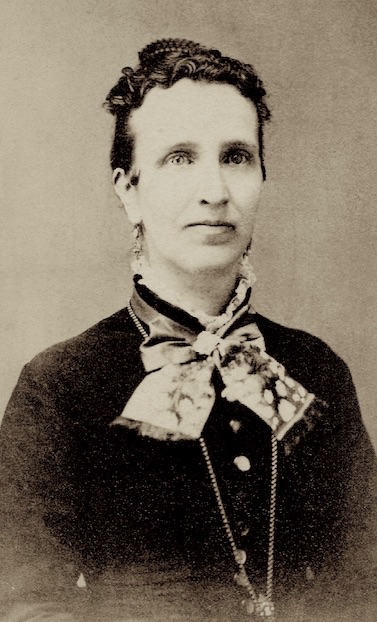
Melissa Sanderson: Could that gold jewelry be handed down from great, great, great, great grand-uncle Robert? (Image is a carte de visite from Ellie Sanderson's Family Album) |
| Their third child, MELISSA SANDERSON (10/9/1839 - 11/25/1921), was a smart, industrious woman who became a school teacher at the amazing age of fifteen. The Riley Township School District had been formed on October 13, 1849, and the school was located opposite the Methodist Church on Maple Street. (The local school probably only had ten grades at that time. The first school year with 12 grades in Memphis was in 1899. Ada Lown, granddaughter of Mary Sanderson-Pincombe, graduated with her teaching degree in 1899 as one of six graduates in the first 12th grade class.)
Education had always been important in the Sanderson family. In 1642, the Puritan government in the colony of Massachusetts passed a law in which parents and the masters of apprentices had to educate their children, or the state would take them away. Then in 1647, another law was passed declaring that towns of fifty families were to provide a teacher for elementary instruction, which created the first public schooling in America. In Michigan, public education was in the first state Constitution of 1837, and the model presented in that document was so successful that it was copied by many states, like California. Classes in the Riley Center area started in May of 1846, and the teacher was paid starting wages of two dollars per week. Melissa qualified to teach primary schools in St. Clair County on November 3, 1855.
RULES FOR TEACHERS (1914)
Courtesy of the Memphis Historical Society |
|
You will not marry during the term of your contract.
You are not to keep company with men.
You must be home between the hours of 8 PM and 6 AM unless at a school function.
You may not loiter downtown in any of the ice cream stores.
You may not travel beyond the ciy limits unless you have permission of the chairman of the school board.
You may not ride in carriages or automobiles with any man except your father or brother.
You may not smoke cigarettes.
You may not dress in bright colors.
You may under no circumstances dye your hair.
You must wear at least two petticoats.
Your dresses may not be any shorter thsn two inches above the ankles.
To keep the classroom neat and clean you must sweep the floor once a day, scrub the floor with hot soapy water once a week, clean the blackboards once a day and start the fire at 7 AM to have the school warm by 8 AM when the scholars arrive.
|
Fortunately for our line, Melissa ended up either quitting, or breaking most of those rules. Later in life, Melissa opened a boarding house in Ypsilanti, Michigan with her daughter-in-law, FLADELLA RAYMOND, to finance the college education of three of her grandsons. The next four generations of our family line would be teachers (I appeared to have broken the streak when I sold a screenplay and quit college—sorry Melissa—but my youngest sister Michele took up the calling and teaches in San Diego County.)
|
Tintype of Laban and Melissa Hause on their wedding day; then on cabinet cards in later years, in a formal full-figure pose and a close-up. (See them in color!)
|
While teaching, Melissa (or "Melissy" as she was sometimes called) was romanced by LABAN HAUSE, a friend of her father's and a recent widower trying to make do while starting a farm and raising a two-year-old daughter, Elma, by himself. (Laban's first wife, SARAH DYSINGER, died from complications after Elma's birth. David Sanderson had witnessed the signing of a deed in Michigan when Laban and Sarah sold some land back in New York.)
21-year-old Melissa had hardly even been romanced with such a strict upbringing, let alone married before like Laban. Still, love blossomed, and in 1860 they were married in Riley Center, Michigan. Melissa raised Laban's daughter as her own, and had four more children with him, as well (listed below).
| CHILDREN OF LABAN HAUSE AND MELISSA SANDERSON |
|
ALICE HAUSE was born on 16 Aug 1861 in Emmett, St. Clair County, Michigan. She married Seneca Young (1857-1898) on 13 Aug 1879 in Millington, just days before her 18th birthday. They had one son, Frank (1880-1963). Seneca died on 9 Aug 1898 in Saginaw City, Saginaw, Michigan, and Alice raised Frank as a single mother. A letter by Melissa Hause from 1920 says Alice was living in a tent in California with her sister-in-law, Rebecca. In 1930, Alice lived alone in Memphis, then moved in with her son. She died on 24 Mar 1939 at Highland Park General Hopsital and is buried at Millington Cemetery in Millington, Tuscola County, Michigan.
|
|
SARAH L. HAUSE was born on 16 April 1863. She died from food poisoning that she contracted from canned beans at the reception of her own wedding to Arthur Baker on 11 Nov 1880 (you can read all about it, below). She was named after her father's first wife, Sarah Dysinger, and they all rest together in the Memphis Cemetery.
Read the obituary notice⁵ following her sad, bizarre death.
|
|
FRANK AUGUSTUS HAUSE was born in 1867. He married FLADELLA RAYMOND (6 Sept. 1869 - 19 July 1961) and had five children, all boys, listed below. Frank died in Memphis, Michigan, on 3 May 1951.
Click on the photo at right to access the Frank Hause Genealogy Page.
See his signature here (from the autograph book of William Pincombe, courtesy of his granddaughter, Judy Ingles).
|
|
EDITH E. HAUSE was born in 1871. She married George W. Cottington (1872-1956) in 1900. They ran a general store in Memphis, Michigan, with her brother Frank and his wife, Fladella (detailed in the next chapter). Edith and Joseph had four children: Frances Mary (1905-1985), William Hause (1911-1956), Josephine Pray (1916-1998), and John Fredrick Cottington (1919-1992). Edith died in 1949.
See her signature here (from the autograph book of William Pincombe, courtesy of his granddaughter, Judy Ingles).
|
|
Two carte de visite cards from the Civil War, probably of Melissa's cousins Henry Greenfield and William Edward Sanderson, in Pennsylvania. (See a Sanderson family photo album here.)
|
Civil War divided the nation in 1861, and divided the men of the Sanderson line from their families along the way. David's son, Edward, and son-in-law James Pincombe would fight for the Union cause. Fortunately, both men survived the war and returned to their families.
David's brother, Edward Waters Sanderson (1809-1876), also had a son in the war, named William Edward Sanderson (1841-1924). The photos at right were found in an old attic in Pennsylvania, near where Edward lived, tucked into an album marked "Sanderson," containing images of David and his children, as well as Edward's. It aso contained the following Civil War portraits, but as the photographs aren't labeled, we don't know the identities of the soldiers.
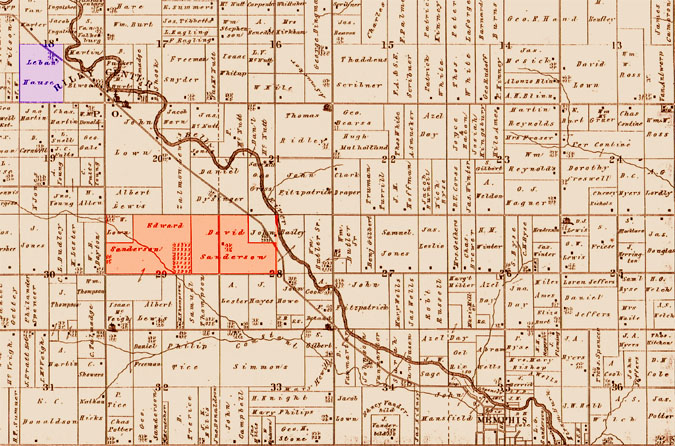
A map of Riley Center in 1876. The farms of David Sanderson and his son, Edward, are in sections 28 and 29; while son-in-law Laban Hause's property (#18) is in blue. (Click to enlarge.) |
Meanwhile, David continued to run the farm after Polly died of cancer in 1867. In 1870 he was running it with his son, Edward. Edward's wife, Juliette, was helped around the house by a domestic servant, and a farm laborer lived there, as well. He was still expanding the farm in 1876, when he purchased 80 more acres from son-in-law Alfred Purdy for $1600 (The Times Herald, Port Huron MI, Monday 07 Dec 1874, Page 4). But by 1880 David had retired completely, leaving the farm to his son, Edward, who owned the land next door, creating a massive, 600-acre farm. Edward in effect became the head of the Sanderson family in the area, and even took over the raising of his brother George's daughter, Orpha, after the death of George's wife, Mary, in 1870.
| Personal Information |
Census Image |
| Name: |
|
David Sanderson |
| Age in 1870: |
|
66 |
| Birth Year: |
|
1804 |
| Birthplace: |
|
Conn |
| Home in 1870: |
|
Riley, St. Clair, Michigan |
| Value of real estate: |
|
10,000 |
| Post Office: |
|
Riley Center |
| Roll: |
|
M593_
699 |
| Page: |
|
405 |
| Image: |
|
312 |
|
|
|
| Personal Information |
Census Image |
|
| Name: |
|
David Sanderson |
| Age: |
|
76 |
| Estimated birth year: |
|
<1804> |
| Birthplace: |
|
Mass |
| Occupation: |
|
Retired farmer |
| Relation: |
|
Father |
| Home in 1880: |
|
Riley, St. Clair, Michigan |
| Father's birthplace: |
|
Mass |
| Mother's birthplace: |
|
Mass |
| Read/Write: |
|
Yes |
|
|
|
|
SOURCE INFORMATION: Data imaged from National Archives and Records Administration.
|
David passed away on January 24, 1884. The Times Herald of Port Huron announced on 20 Feb 1884 (Wed., Page 2) announced, "David Sanderson died in Riley January 24, aged 80. He had lived in Michigan nearly 33 years and came from Ohio. He lost his wife sixteen years ago. Three daughters and two sons survive him, all married." His headstone reads, "Aged 79 Y's, 8 M's 4 D's." He and Polly Briggs-Sanderson are buried side-by-side in the Memphis Cemetery in Memphis, Macomb County, Michigan.
|
David and Polly Sanderson's stone at the Memphis Cemetery. The entire cemetery is here.
|
In April of 1884, just a few months after David's death, Edward opened a cheese factory about two-miles southeast of Riley Center. In an interview on her 108th birthday, neighbor Annie Cawthorne, a longtime resident of the area, recalled to the reporter how as a child she walked to the "Cheeses Factory" to buy cheeses from Ed Sanderson. He aged the cheese in large wooden barrels, producing fifty pounds of cheese per day. He was also the first farmer in the area to raise Holstein cows, which produced milk for the outstanding cheese made for the people of Riley and surrounding communities.
Edward retired around 1900, then died in 1907. Then by 1916, some of the Sanderson farmland had been sold to the Henry E. Dysinger family. (Henry was the son of Daniel Dysinger from Fayette, Seneca Co., New York. The Dysingers also acquired a portion of the John Bailey property, for a total of 229 acres, with the Belle river running through). The rest of the Sanderson land was subdivided, with the largest portion owned by Mrs. L Hause ("Melissy," as Annie Cawthorne, who later bought the property, called her). Melissa said in a letter that she sold the family farm to the Dysinger family in 1920, and moved to Memphis.
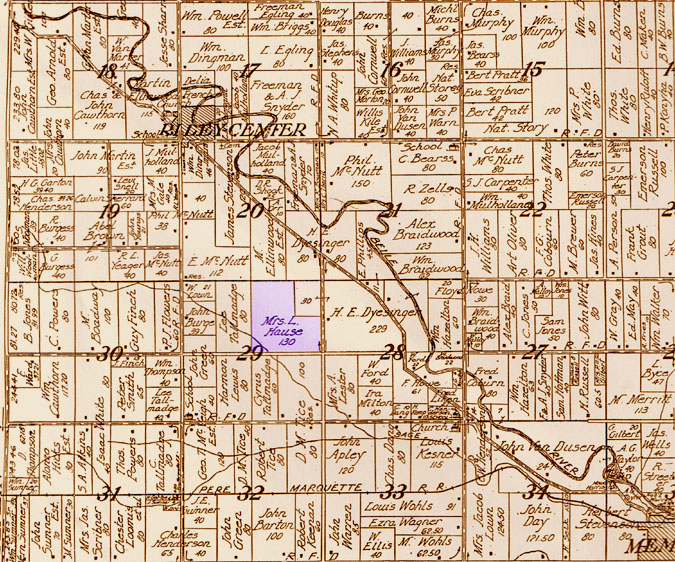
Melissa Hause's inherited property, shown in this map from 1916. (Click to enlarge.) |
| Personal Information |
Census Image |
|
| Name: |
|
Melissa L Hause |
| Age in 1910: |
|
70 |
| Estimated birth year: |
|
1840 |
| Birthplace: |
|
Ohio |
| Home in 1910: |
|
RILEY TWP, ST CLAIR, Michigan |
| Series: |
|
T624 |
| Roll: |
|
673 |
|
|
|
| Personal Information |
Image |
|
| Name: |
|
Malissa Hause |
| Age: |
|
80 |
Birth
year: |
|
1840 |
| Birth place: |
|
Ohio |
| Race: |
|
White |
| Home in 1920: |
|
Riley Township, St. Clair Co., MI |
| Home : |
|
Owned |
| Marital status: |
|
Widowed |
|
|
|
SOURCE INFORMATION: Data imaged from National Archives and Records Administration. 1910 and 1920 Federal Population Census. Washington, DC: National Archives and Records Administration.
|
| Newspaper Article |
File Image |
| Title: |
|
Melissa Hause |
| Newspaper: |
|
Port Huron Times-Herald |
| Subject: |
|
Obituary |
| Original Publication Date: |
|
November, 1921 |
|
|
|
"Melissy" then died on 25 Nov 1921. An estate of $10,700 was left to her heirs, in a will filed for probate with Judge George L. Brown. Of this, $8,000 was personal property. Josephine Cottington, granddaughter, received Melissa's gold watch and chain. Her son, FRANK HAUSE, was named executor.
Melissa may not have inherited a fortune from Robert Sanderson, but she was a bold, bright, frontier woman who enriched the family in every other way. She became a school teacher at fifteen, then ran a boarding house in her sixties to help put her grandchildren through college. Through her efforts and determination, the Hause family was transformed from 19th Century farmers into 20th Century educators. Melissa displayed her creative skills by making clothing for the family with a spinning wheel (shown at the bottom of the page), and the entire family wore her handiwork proudly in photographs. But as the family motto says, "Je suis veillant à plaire."

Two Sanderson sisters pose for a group portrait by Welch Photo @1910: Top Row—Mary Anne Coburn-Cottington (mother of Melissa Sanderson-Hause's son-in-law, George), Ella Stevenson, S.J. Asquith, Alfred Kesner, Mr. Raven, Mrs. Raven, Nellie Kesner. 2nd Row—Mrs. Braidwood (Wm), Melissa Sanderson-Hause, Esther Sanderson-Purdy, Edna Asquith, Mrs. Dunning, Mrs. Alex Braidwood, Mrs. Cornell. Front row—Mrs. Parker, Mr. Parker, Mr. Gifford, Mrs. Gifford (full list and colorized version). SOURCE: Memphis Historical Society. |
NOTES ON THIS PAGE:
¹—According to family historian Kevin Sanderson, a descendant of Edward, the source for this conjecture would be the Sanderson pedigrees of respected Northamptonshire antiquarian and genealogist Rev. Henry Isham Longden, which are now in the Northamptonshire Records Office (the work by Longden seems to be for someone in the Sanderson line in the United States, who already knew Robert was born about 1608, that Robert and Lydia married in England in 1636, had a child there named Lydia in 1637, and arrived in 1638, where they had Mary in 1639, and Lydia's death about 1641. They also included his brother Edward's marriage and Edward's only child, Jonathan). The Reverend Longden gathered and cataloged all the Northamptonshire records in the late 1800s. They show an Edward (or Edmond) Saundersonne being baptized on 5 May 1611, and there are repeated generations in this line of the family with people named Edward and Robert. This genealogy takes the line back in Northamptonshire to about 1455, to the birth of a man named just Sanderson in the records.
In the information someone had provided to Longden for his search, they included "perhaps a sister" named Susanna born about 1620, that Longden wrote down along with Robert and Edward's information in notes on the bottom of the first scratch pedigree he did, plugging their names into where they might fit . He found that Edward Saundersonne had a daughter named Susan baptized in 1612, Edward's (and Robert's) younger sister. The next child in line was Elizabeth baptized in 1615. So Robert, Edward and Susan would have been closer elder siblings to their younger brothers and sisters:
CHILDREN OF EDWARD SAUNDERSONNE AND (?) WINGFIELD |
| ROBERT SAUNDERSONNE (SANDERSON) was born @ 1608, in Higham Ferrers, England. Unfortunately, any records of Robert's birth, as well as his father's marriage, would be on two missing pages from the Northamptonshire records, covering early 1607 to 1611, if they exist, so this is unproven. |
| EDWARD (or EDMOND) SAUNDERSONNE (SANDERSON) was baptized on 5 May 1611 in Higham Ferrers. |
| SUSAN SAUNDERSONNE baptized in 1612 Higham Ferrers. |
| ELIZABETH SAUNDERSONNE was baptized in 1615 Higham Ferrers. |
As for the genealogy of William Sanderson, Edward and Robert Sanderson of Higham Ferrers had a distant cousin named William, who Rev. H. I. Longden uncovered while creating pedigrees in Northamptonshire. Rushden Research lists him as William, christened 7 Feb 1630, the son of John Sanderson and Anne Matthew. Going back a few generations, the family genealogy looks like this:
CHILDREN OF SANDERSON |
| GEORGE SANDERSON m. Alice (?), and they were buried 1600/1601 in Higham Ferrers, Northamptonshire, England. George would have been Edward and Robert's great-uncle. |
| EDWARD SANDERSONNE (grandfather of Robert and Edward) was George's younger brother, b. in Higham Ferrers, Northamptonshire, England. |
CHILDREN OF GEORGE SAUNDERSON AND ALICE (?) |
| ROBERT SANDERSON m. Anne (?) in 1592 in Higham Ferrers, Northamptonshire, England. |
CHILDREN OF ROBERT SANDERSON AND ANNE (?) |
| JOHN SANDERSON m. Anne Matthew in 1626 in Higham Ferrers, Northamptonshire, England. |
CHILDREN OF JOHN SANDERSON AND ANNE MATTHEW |
| WILLIAM SANDERSON was christened 7 Feb 1630 in Higham Ferrers, Northamptonshire, England. |
There is no record of this William Sanderson's burial in Northamptonshire, from what Longden could find, so it is possible that he sailed to America—but was too old to claim he was 40 in a legal deposition in 1681 (Henry Bond's Genealogies of the families and descendants of the early settlers of Watertown, Massachusetts, including Waltham and Weston notes: "In a suit, Mar. 26, 1681, Wm. Sanderson was a witness, then aged 40, showing that he was b. in 1641. This could not be the William Sanderson, who took the oath of fidelity in 1652.") UPDATE: Kevin Sanderson found the court record of the Oath and it shows Edward, not William, on the document (Page 301 from the Middlesex County Court Records, FHL film 892250, which had apparently been recorded incorrectly in the NEHG Register).
According to Kevin Sanderson, "A William Sanders was written about as early as 1636. He was a carpenter/servant apparently working off his passage to the colony. There's a young William Sanders who had property in Hampton in 1638 when it was settled. He's is mentioned in at least two places regarding being a settler. And mentioned as a carpenter in another. Robert Sanderson was called Saunderson in the Hampton records and usually Sanderson after (but we know he could read and write being a goldsmith/silversmith so he may have caught most of the clerical mistakes before they happened), and his nephew William was often called Sanders or a variation but also Sanderson. Edward Sanderson was more often called Sanderson, but there are a small number of places where he was called Sanders, Sandors or Sandurs, the last which may just be bad penmanship as it looks in the original records like bad writing of Sanderson with a trailing s-o-n. There is enough space in the timeline between the birth of Robert and the birth of Edward for another brother, and since Robert, Edward and William were popular names for sons in the area of Higham Ferrers, it is very likely there was a son named William in that family as well. The pages of the church register covering about 3 1/2 years are missing, unfortunately, but we know enough to see it as their likely home."
Kevin Sanderson speculates that Robert could have helped this William Sanderson sail to America from Higham Ferrers, England, to work on Robert's farms when he moved to Boston. This could be why Robert bought neighbor William Godfrey's house and property when he was leaving. Since William testified in the drowning death of Thomas Hastings' son, it would make sense that he lived in the Godfrey house, next door up the hill from Hastings' house, and participated in activities with the neighbors.
"Higham Ferrers William" would have been 36 when he married Sarah in Watertown, which seems a little old to be starting his first family (although Kevin Sanderson states that everybody in this line married older).
So all this could point to TWO Williams, as Bond had speculated (and if the Higham Ferrers theory proves true, anyway), and still leaves us with a younger William Sanderson living in the area of Watertown.
Still, Northamptonshire, with Little Addington, Higham Ferrers, Rushden and Wadenhoe, had Sanderson families living there for hundreds of years, but there are several other small towns in England called Higham, as well, and Robert could be from one of those, too. So the identity of Robert's parents (not to mention Edward's and even William's) may forever be unknown. Maybe genetics will provide a clue.
|
| Book Information |
Book Image |
|
| Name: |
|
Western Massachusetts, a history, 1636-1925 |
| Author: |
|
John H. Lockwood |
| Publisher: |
|
Lewis historical publishing company |
| Year: |
|
1926 |
| Subject: |
|
Walter Whitney Sanderson |
| Pages: |
|
668-669 |
|
|
|
|
A genealogy of the William Sanderson line; Published 1926 by Lewis Historical Publishing Company, Inc., in New York and Chicago. Library of Congress: F64.L76.
|
|
²—Genetic testing is a way to scientifically determine my true Hause lineage. This is done through paternal genes (Y-chromosomes), inherited from father to son largely unchanged for many generations (as in centuries). I would love to also obtain scientific proof of the familial ties between Robert, Edward and William Sanderson once and for all, but my link to the Sanderson family is maternal, through my great, great, great grandmother. But have direct male descendants proved or disproved the relationships between Robert, Edward and William Sanderson? Well, the answer is apparently yes, that they ARE definitely related, through 37-marker and 67-marker Y-DNA tests of various male descendants of the brothers, but more in-depth testing, like 111-marker tests or Family Tree DNA's new "BIG-Y" test (featuring an amazing 25,000 known SNPs and 10 Million base-pair coverage) could determine whether they're cousins, brothers, etc. Anyway, here are some results:
CHARLES SANDERSON of Phoenix, AZ, is a descendant of Edward Sanderson. He writes: "I have a 67-marker test, not a 111 marker test. So the Percentage goes down. I was trying to find something like this, last night that showed for 67-marker matches. Basically the further one goes back, the more likely they're related. So, if I matched with somebody at a genetic distance of 4. So we have two close matches, with a need for further verification in the tree. Match #1 is Robert W. Sanderson on Familytreedna.com that matches me at 67 markers with a genetic distance of only 2. Then there is a Robert W. Sanderson on ySearch that listed only 37 markers, and lists Robert (b. 1608) as an ancestor. I suspect this is the same person, and they either upgraded to a 67 marker test after giving that information on ySearch, or they just didn't enter the entire test result. On the premise that they are the same person, I am matched to Robert W. Sanderson at a genetic distance of 2 on 67 markers. At Familytreedna.com, when I sign in I can see a "TiP" report, that If I go back 12 generations it 90.68% likely we share a common ancestor. The odds are 94% that Edward and Robert's dad is our link. The odds are 97.37% that it's Edward and Robert's grandfather. The TiP report will even recalculate odds if one knows there wasn't a match going back X generations. When I put in 9 or 10 generations, our likelihood of an ancestor still stays strong at 90%. So because we're dealing with a range, it doesn't matter quite as much that my match is at a different generational distance. Even at 10 generations back, the odds are great that we have a common ancestor. Anything is possibly, but I think we can infer 90% likelihood that Edward and Robert are brothers, but we don't know if William is a son, brother or cousin (on DNA alone). But DNA undoubtedly proves he's connected. What makes it interesting is that I also have... Match #2 John Francis Sanders (who lists Robert, born 1608 as an ancestor) matched at a genetic distance of 4 and it shows that this person's likelihood of being a match 12 generations ago is 78.66%, and 16 generations ago, it's 93.39% Splitting the difference, the odds are around 90% that we have a common ancestor 15 generations ago (Robert and Edward's father). When matched up against genealogical records (assuming John Francis' tree is accurate) that gives us higher odds that Robert and Edward are brothers, if not, first cousins."
Here are Charles Sanderson's results from ySearch compared with several sets of Y-DNA results from Familytreedna.com, with ancestors listed as Robert and Edward Sanderson. For privacy, I'll just show the first twelve markers, the most basic genetic test to see if people are related:
| Ancestor |
Haplo |
DYS393 |
DYS390 |
DYS19 |
DYS391 |
DYS385 |
DYS426 |
DYS388 |
DYS439 |
DYS389i |
DYS392 |
DYS389ii |
| Edward (yS) |
Unk. |
13 |
23 |
14 |
11 |
11-14 |
12 |
12 |
11 |
13 |
13 |
29 |
| Robert (FTDNA) |
R1b1a2 |
13 |
23 |
14 |
11 |
11-14 |
12 |
12 |
11 |
13 |
13 |
29 |
| Edward (FTDNA) |
R1b1a2 |
13 |
23 |
14 |
11 |
11-14 |
12 |
12 |
11 |
13 |
13 |
29 |
| William (FTDNA) |
R1b1a2 |
13 |
23 |
14 |
11 |
11-14 |
12 |
12 |
11 |
13 |
13 |
29 |
The full report indicates that test results naming Robert Sanderson as the furthest known paternal ancestor do match a descendent of Edward's, which calculates to within 90% odds that Robert and Edward are brothers. A direct male descendant of William recently added his results, with 37-markers.
Meanwhile, a second line has opened from Joseph Sanderson (b. 1713), son of Bethiah Kemp: it has been confirmed using Y-DNA evidence that Joseph's father was not Joseph Sanderson, but a Lakin. In a 1714 Groton bastardy court case, Bethiah named Joseph Sanderson the father (Joseph adamantly denied it in his testimony). But the judge ruled in her favor (as happened in almost all cases of this kind). Testing showed that the Y-DNA of Joseph 1713 descendants differed completely from the descendants of Joseph Sanderson (b. 1680), William Sanderson (b. 1643), and immigrant Edward Sanderson. The "1713" descendants did however match a Y-DNA test kit of a unidentified male named Lakin. Ethel Sanderson Hegeman pointed out that the Lakins were a big family in Groton in 1713. So, she and Alexandra Sanderson Stocker went to work finding a descendant of these Groton Lakins and had him test. He was a clear match to all of us "1713" Sanderson descendants. It is not clear which Lakin man fathered Joseph (there were five men that they think could have). But there was only one Lakin immigrant to America that was the ancestor to the Groton Lakins, and his name was William Lakin of Ruddington, Nottinghamshire, England. So descendants of Joseph Sanderson and Bethiah Kemp now have two lines of ancestors: 1) the natural line of William Lakin of Ruddington, and 2) the legal line of Joseph Sanderson (b.1680) as we remain heirs of the Sandersons in the eyes of the law.
³—The book "Divided We Stand," by Roger Thompson, mentions a man named William Sanders in Groton while our ancestor and his family were recorded in Watertown. Thompson uses the name Sanders—not Sanderson—throughout the book (Robert Sanderson is the only person he mentions with the full "Sanderson" name, and Thompson says in his notes section that he is not related to the Edward and William Sanders who are featured in his book). According to Kevin Sanderson, "They are definitely two different people. There is a Willyam Sandors—also spelled Sanders and Sanderson in different birth listings in the print version of the Watertown Vital Records—with several children born in Watertown through 1679, who was married to a woman named Sary in 1665. But the William Sanders who Roger Thompson refers to hung around with a younger crowd of trouble makers and left for Groton, MA around 1674, deserting his wife Mary around that time for another woman. However, our Willyam Sanderson was still in Watertown making babies with Sary." (Those children would be "Lydia Sanderson, daughter of Willyam and Sary Sanderson," born on 21 Apr 1679, in Watertown, and "Joseph Sanderson, son of Willyam and Sary Sanderson," born on 28 Aug 1679/80 in Watertown. Joseph is in the will of Robert, and Lydia is in the will of Robert's third wife, Elizabeth.) This is not to say that the William Sanderson of this genealogy couldn't have moved back later, or that he wasn't massacred in 1694—Robert Sanderson did call him "William Saunderson of Groton," in his 1693 will, and even gave William's son a musket—I'm just saying that more research needs to be done to differentiate all the different Sanders' and Sandersons in the area. In my never-ending quest to muddy the waters even further, here are the county probate records:
| Name |
Date |
Location |
Record Type |
Case Number |
Last Residence |
N.E.H.G.S. Link |
| William SANDERSON, SAUNDERSON |
1694 |
Middlesex, Massachusetts |
Probate Record |
19828 |
Groton |
8125371 |
| Joseph SANDERSON, SAUNDERSON |
1694 |
Middlesex, Massachusetts |
Probate Record |
19829 |
Groton |
8059385 |
| William SANDERSON, SAUNDERSON |
1729 |
Middlesex, Massachusetts |
Probate Record |
19830 |
Shrewsbury |
8126806 |
| William SANDERSON, SAUNDERSON |
1730 |
Middlesex, Massachusetts |
Probate Record |
19831 |
Sudbury |
8125812 |
| Isaac SANDERS, see SAUNDERS, SANDERSON, SAUNDERSON |
1730 |
Middlesex, Massachusetts |
Probate Record |
19832 |
Sudbury |
8060303 |
| Joseph Jr. SANDERSON, SAUNDERSON |
1734 |
Middlesex, Massachusetts |
Probate Record |
19807 |
Groton |
8060185 |
| Jonathan SANDERSON, SAUNDERSON |
1735 |
Middlesex, Massachusetts |
Probate Record |
19801 |
Watertown |
8127055 |
| Joseph SANDERSON, SAUNDERSON |
1736 |
Middlesex, Massachusetts |
Probate Record |
19808 |
Groton |
8125745 |
| William SANDERSON, SAUNDERSON |
1737 |
Middlesex, Massachusetts |
Probate Record |
19811 |
Groton |
8060726 |
| Abiah SANDERS, see SAUNDERS, SANDERSON, SAUNDERSON |
1739 |
Middlesex, Massachusetts |
Probate Record |
19778 |
Waltham |
8059901 |
| Sarah SANDERSON, SAUNDERSON |
1741 |
Middlesex, Massachusetts |
Probate Record |
19809 |
Groton |
8126055 |
| Susanna SANDERSON, SAUNDERSON |
1741 |
Middlesex, Massachusetts |
Probate Record |
19809 |
Groton |
8056148 |
| John SANDERSON, SAUNDERSON |
1741 |
Middlesex, Massachusetts |
Probate Record |
19809 |
Groton |
8059085 |
| Gideon SANDERS, see SAUNDERS, SANDERSON, SAUNDERSON |
1741 |
Middlesex, Massachusetts |
Probate Record |
19809 |
Groton |
8060042 |
| Joseph SANDERSON, SAUNDERSON |
1741 |
Middlesex, Massachusetts |
Probate Record |
19810 |
Groton |
8060134 |
| Jonathan SANDERSON, SAUNDERSON |
1743 |
Middlesex, Massachusetts |
Probate Record |
19802 |
Waltham |
8060418 |
SOURCE: Middlesex County, MA: Index to Probate Records, 1648-1871, compiled under the supervision of Samuel H. Folsom and William E. Rogers (successively) and published between 1912 and 1914. Published in two volumes, the first contained entries from 1648 to 1871, while the second included the years 1871 to 1909. The full records are held at the Massachusetts Archives and they are also available on microfilm at the NEHGS Research Library. To obtain photocopies of a particular packet, please visit the NEHGS Research Services web page and fill out the form for in-depth research. The original text can be viewed at the NEHGS Research Library. |
More evidence that Edward Sanderson was not Edward Sanders/Saunders, via Kevin Sanderson, found in "Edward Sanders/Saunders trial manuscripts from the Massachusetts Archives: Vol. 38B," Pg. 185 - 190. "Edward Rawson, Secretary of the General Court for many years, wrote 'Saunders' in his entries. 'Sanders' was also used by the other members of the General Court with their entries. Edward Rawson was on the mint committee so he knew Robert Sanderson, and he wrote 'Robt Saunderson' when Robert was deposed and sworn in for the mint on August 19, 1652 (http://www.coins.nd.edu/ColCoin/ColCoinIntros/MAMintDocs.chron.html). Rawson would have no problem then writing the name as 'Saunderson,' and besides any kind of 'son' since 'son' was on the end of his name as well. The name of Edward Saunders is quite clear." (SOURCE: Elizabeth Bouvier, Head of Archives: MA Supreme Judicial Court, 3 Pemberton Sq., 16th Fl., Boston, MA 02108-1701. (617) 557-1082 Ph; (617) 557-1088 Fax)
⁴—No death recorded, but there was at least one Elnathan Sanderson in the war: in Massachusetts Soldiers and Sailors in the War of the Revolution, Vol. 13, p. 792: Sanderson, Elnathan, Deerfield. Private, Capt. Benjamin Phillips's co., Lieut. Col. Timothy Robinson's detachment of Hampshire Co. militia; muster roll dated Garrison at Ticonderoga, Feb. 24, 1777; enlisted Dec. 23, 1776; enlistment to expire March 23, 1777; reported on command at the landing; also, [p. 792] same co. and detachment; entered service Dec. 23, 1776; discharged April 1, 1777; service, 100 days, at Ticonderoga; also, Private, Capt. James Keith's co., Col. Michael Jackson's regt.; Continental Army pay accounts for service from March 27, 1777, to Dec. 31, 1779; residence, Deerfield; credited to town of Deerfield; also, Gen. Washington's guards commanded by Maj. Gibbs; Continental Army pay accounts for service from March 28, 1777, to Dec. 31, 1779; said Sanderson reported as having been discharged in a copy of a discharge dated Morristown, March 28, 1780, signed by C. Gibbs, Major Commandant of Guards; also, account rendered against the United States for amounts paid by the Commonwealth to Maj. Caleb Gibbs and men in Col. Washington's guards and others, as exhibited by Committee on Claims in behalf of Massachusetts against the United States Sept. 21, 1787. Who knows...maybe Robert just ASSUMED Elnathan I was dead and used the name again.
⁵—Massachusetts, Town and Vital Records, 1620-1988 [database on-line]. Provo, UT, USA: Ancestry.com Operations, Inc., 2011. Original data: Town and City Clerks of Massachusetts. Massachusetts Vital and Town Records. Provo, UT: Holbrook Research Institute (Jay and Delene Holbrook).
|
| Probate Information |
Image
|
|
| Name: |
|
Elnathan Sanderson |
| Executor: |
|
Venus Coon; Smith Bockus |
| Executrix: |
|
Prually Sanderson |
| Year: |
|
1855 |
| Subject: |
|
Last Will & Testament |
| Pages: |
|
328-331 |
|
|
|
|
Jefferson Co., New York Wills, Vol. 3, p. 328 - 331. Will dated 17 April 1852 /s/ Elnathan Sanderson. Witnesses: Venus Coon of LeRay, Jeremiah Smith of Philadelphia, and Bethany A. Coon of LeRay, NY Will, proved: 5 February 1855.
|
|
⁶—Elnathan Sanderson Estate (Jefferson Co., NY Wills, Vol. 3, p. 328): "In the matter of the estate of ELNATHAN SANDERSON of Philadelphia, Jefferson Co., NY: On 30 December 1854, VENUS COON of LeRay, petitioned to open probate. Heirs/next of kin:"
- BETSEY SANDERSON of Philadelphia, NY
- JULIA ANN ALLEN, wife of WILLIAM ALLEN of Antwerp, NY
- DAVID SANDERSON of Memphis, St. Clair Co., Michigan
- EDWARD SANDERSON
- DELANA VENNER, wife of MORGAN VENNER
- SHERMAN SANDERSON
- SYLVICE CHEENA, wife of ELIPHALET CHENA (CHENEY in pencil), of Michigan
- AMANDA SMITH, wife of JEREMIAH SMITH of Antwerp, NY, all of full age and children of testator.
- PRUALLY SANDERSON of Philadelphia, of full age, widow of the deceased.
WILL OF ELNATHAN SANDERSON: ELNATHAN SANDERSON named his wife, PRUALLY. Named his children: BETSEY, JULIANN, DAVID, DELANY, SHERMAN, AMANDA and SYLVIA. Named his wife, PRUALLY, as executrix, and VENUS COON of LeRay as executor, and SMITH BOCKUS of Philadelphia, as executor. Will dated 17 April 1852.
/s/ Elnathan Sanderson
Witnesses: Venus Coon of LeRay, Jeremiah Smith of Philadelphia, and Bethany A. Coon of LeRay, NY
Will proved: 5 February 1855.
⁷—FENNER - BROUGHTON FAMILY HISTORY: The Family of JAMES ELORY FENNER (1844-1912) and HESTER ADAMANTHA (BROUGHTON) FENNER (1847-1922) of Crawford County, Pennsylvania, by Jim Fenner, 1995. Closson Press; 1935 Sampson Drive, Apollo PA 15613-9209 (Pages 24-31):
James Elory Fenner's parents were Morgan Lewis Fenner and Delaney Sanderson... Delaney's father was Elnathan "Edward" Sanderson, whose family was living in NY between 1820 and 1830 (Herkimer Census, 1820, 1825, 1830). Delaney's younger sister Sylvia married Eliphalet Cheney... The following reminiscences of Morgan Lewis and Delaney (Sanderson) Fenner are quoted from J. Lewis Fenner's unpublished autobiography: "My earliest recollection of Grandma Delaney Sanderson Fenner was when I was very little... Delaney Sanderson's parents were Elnathan and (according to family tradition) Martha (Matilda) Sanderson. Elnathan moved to Herkimer Co., NY, perhaps from Greenwich Twp., Hampshire Co., Massachusetts, where in 1790 an Elnathan Sanderson and his wife were living with one young boy and one young girl... In the 1810 Census in the town of Russia, Herkimer Co., NY, the household of our Elnathan Sanderson is listed as consisting of 1 male and 1 female 26-45 and 2 males and 2 females under 10. The 1820 Census shows that by then the family had grown, adding two males and two females under the age of ten. In the 1825 [N.Y. State] Census, with the name spelled Saunderson, there were still five males and five females, but three of the females were under 16, and all five were single. This suggests that Elnathan's first wife may have died sometime between 1820 and 1825." (It goes on to list a son, David Sanderson, living in Michigan, with no further information.)
⁸—Past and Present of MACOMB COUNTY, MICHIGAN, by Robert F. Eldredge, together with Biographical Sketches of it's Leading and Prominent Citizens and Illustrious Dead. Chicago: The S. J. CLARKE Publishing Co. 1905. EDWARD R. SANDERSON (Pages 268-271):
The life record of Edward R. Sanderson is formed by a long period of activity in business circles crowned by a well earned rest, for he is now living in Romeo, enjoying the fruits of his former labor. For many years he figured as one of the active and successful farmers of St. Clair county and its numbered among the early settlers of this portion of the state, having located in St. Clair county in 1850.
Like many of the representative citizens of Eastern Michigan, Mr. Sanderson claims New York as the state of his nativity, his birth having occurred in Herkimer county, November 21, 1831. The family was established in the new world in colonial days and his grandfather, Elnathan Sanderson, was born in Massachusetts in the year which gave birth to the American republic—the year in which the Declaration of Independence was signed. He was the youngest in a family of fourteen children and in 1806 he removed from the old Bay state to New York, settling in Herkimer county. His son, David Sanderson, the father of our subject, was born in Massachusetts, was reared in Herkimer county, New York, and when he had reached man's estate was married to Miss Polly Briggs, who was born in New York, August 6, 1811. He then devoted his attention to agricultural pursuits in Herkimer county for a number of years, while later he removed to Geauga county, Ohio, arriving there in May, 1834. He followed farming in that locality for a number of years and then removed to Michigan in 1850. The following year he located just across the boundary line of Macomb county in St. Clair county, where he purchased wild land that was covered in a dense growth of timber. This he had to clear away before he could plant crops, but his persistent efforts soon wrought a transformation in the place, and where once was seen tall trees there were later found fields of waving grain. He continued to engage in farming upon the old homestead there and departed this life in January, 1884. His wife had passed away in 1867.
Edward R. Sanderson was the oldest of five children, all of whom reached mature years. Mary, the next in order of birth, was born May 20, 1834, and married James Pincombe, but is now deceased. Melissa, born October 9, 1839, is the wife of Laban Hause, of Memphis, Michigan. Esther, born January 6, 1842, is the wife of Alfred Purdy. George W., born January 6, 1848, married Jessie Schuman and is now at Palm Beach, Florida.
Edward R. Sanderson came to Michigan when a young man of nineteen years. He had attended the public schools of Ohio but is largely self-educated, his mind being continually broadened by experience in the business world as well as through reading and observation until he is now a well informed man. He assisted his father in the development of the home farm in St. Clair county and afterward purchased land and engaged in farming on his own account in that county for more than thirty years. He made a specialty of dairying and his products from the dairy found a ready sale on the market. He erected a good residence and was one of the prosperous agriculturists of his portion of the state, having a valuable farm of six hundred acres, of which five hundred acres was under cultivation. He made many improvements upon his place, operating the fields with the latest improved machinery, and his dairy plant was also splendidly equipped. He kept sixty cows for dairy purposes and for forty years was successfully and extensively engaged in the manufacture of cheese.
On the 21st of September, 1858, Mr. Sanderson was married in Bruce township, Macomb county, to Miss Julia E. Edgett, who was born in that township, March 20, 1837, and was there reared and educated. Her father, Albert Edgett, was one of the early settlers of Macomb county. His birth occurred in Ontario county, New York, February 3, 1805, his father being Peter Edgett, who was also born in the Empire state in 1770 and died December 13, 1831. The son was reared in Ontario county and was there married to Miss Lucy H. Adams, a daughter of John and Susannah (Morse) Adams. She was born in New Hampshire, April 22, 1807, and was reared in the Empire state. To Albert Edgett and his wife were born one son and six daughters: Cleora, born March 9, 1829, was married July 20, 1854, to Samuel Babcock, who died in 1897, while her death occurred June 19, 1882. Phebe P., born February 21, 1831, was married July 20, 1854, to Hart Perkins, and they reside in Oxford, Michigan. Louisa H., born December 13, 1832, was married November 28, 1853, to Jacob T. B. Spillman, who died in 1897, and she makes her home in Romeo. Marietta E., born October 25, 1834, was married March 4, 1857, to Samuel F. Aldrich, who died August 3, 1894. Julia E. is the next of the family. Martha J., born June 25, 1839, was married November 7, 1878, to Levi W. Cole, and died March 14, 1901. Albert P., born August 20, 1841, married Sarah Hobbs, of Louisiana, during the Civil war.
Mr. Sanderson removed from the farm to Romeo in 1890, purchasing residence property on Main street, where he has since lived retired. He has invested his capital in Michigan lands and gives his supervision to his property interests, but otherwise is enjoying a well-earned rest. He has been a sta(u)nch republican since casting his first presidential ballot for the first candidate of that party—John C. Fremont—in 1856. He has never sought or desired office, but has given his attention to his farm and business affairs and his close application and energy have been rewarded by a handsome competence. His wife holds membership in the Methodist Episcopal church of Romeo and he attends its services with her and contributes to its support. He manifested his loyalty to his native country at the time of the Civil war by enlisting in March, 1865, as a member of Company D, Twenty-second Michigan Infantry. He went south to Chattanooga, where he remained for three months and was then transferred to Company B, Twenty-ninth Michigan Infantry, where he did guard duty along the railroad, serving in that capacity the greater part of his time until he mustered out. He was honorably discharged at Murfreesboro, Tennessee, September 6, 1865, and he is now a member of the Grand Army post at Romeo, in which he has served as commander. He is recognized as a man of good business capacity and of sound judgment, whose affairs have been capably managed while the visible evidence of his life of thrift and industry is the property which he owns in Romeo and in Macomb and St. Clair counties.
COUSINS, COLLABORATORS & CO-CONSPIRATORS...
|
|
ALEXANDRA SANDERSON STOCKER (James, Albert LeGrand, William Wing, Albert LeGrand, Rufus, Isaac, Isaac, Joseph (NPE), Joseph, William Sanderson) is the resident expert on all things Sanderson, owning the Family Bible of her great, great great-grandfather Rufus and having traveled across the country researching the family. In fact, she is so diligent in her research that she uncovered through court records and DNA testing that her line of Sanderson ancestors were actually Lakins! (Now she's the resident expert on all things Lakin, too, and gets to research TWO paternal lines in Groton, Massachusetts!) You can read the fascinating diary of her great-grandfather here.
|
|
KEVIN SANDERSON is a descendant of Edward Sanderson, by way of family members from Massachusetts, Vermont, Ohio, Indiana to Michigan (Glenn, Earl, Wilbur, Joel, James, James, Benjamin, John, Jonathan, Edward Sanderson). He has spent many hours on his ongoing quest to clear the good name of Edward Sanderson from faulty accusations made by lazy part time Internet genealogists who confused him with Edward Sanders of Watertown, who commited terrible crimes and had a name much too similar to Kevin's ancestor. (I was one of those lazy part time Internet genealogists, BTW; don't believe every family tree you find on Ancestry.com!) See his Edward Sanderson page here.
|
 |
Much of the Massachusetts-era information for this genealogy was compiled by GARY SANDERSON (Robert, Waldo, Willis, Thomas, Edward Chapman, Maj. Thomas, Dea. Thomas, Joseph, Joseph, William Sanderson), who like Alexandra also turned out to be a Lakin! Gary uncovered all of the information on Robert Sanderson's third wife, Elizabeth Kingsmill, widow of Quaker Wm. Kingsmill, who was punished by 15 stripes in 1660, within days of Mary Dyer's hanging on the Boston Common. (He has plenty of happier stories, too.) "Joseph II was the grandson of William, son of Joseph I, from the Groton, Ma., line to Whately, Ma. You show Joseph of Whately in your data that I copied. He died in Whately in 1772, the oldest grave in the East Whately burial ground. His wife was Ruth Parker of Groton. I descend from his son, Dea. Thos. Sanderson of Whately, a prominent man in Whately history who made his fortune in the tanner/cordwainer trade. He was a Lt. in the Revolution. In 1803, he left his East Whately home for what is today known as Whately Glen, previously Sanderson's Glen, previously Indian Hill. He left behind son and my ggggf Maj. Thos to take over his tannery. Maj. Thos. was followed into the trade by gggf Edward Chapman Sanderson. The original Sanderson farmstead (ca. 1765) burned to the ground in July 1882, displacing the family. I have the Sanderson cobbler's chest full of tools with hand-whittled handles, winter chores in front of the fire." Check out his blog!
|
|
JEANIE ROBERTS is an administrator at The Foundation for Hope Village in Texas. She is an amateur genealogist and family historian who is interested in more than just names and dates. As a history buff, she loves to place her ancestors in their time and imagine how their lives were lived. She also is trying to weed out the junky genealogy that she finds on the web. Check out her fascinating, incredibly detailed and thoughtfully researched blog, about many early American families beyond the Sandersons.
|
|
JOYCE KEENEY (née: McKEEHAN), my 3rd cousin 2x removed (Lela Irene Lown, Polly Jennie Pincombe, Mary Cordelia Sanderson, David, Elnathan, Robert, William Sanderson), is James and Mary Sanderson-Pincombe's great-granddaughter, and has been an immense help in uncovering the Michigan era of the Sanderson family, and in contacting residents of Memphis, Michigan, who still remember the Hause, Sanderson and Raymond families. Recently, she found crucial information on the life of George Sanderson of Riley Center, Michigan. Speaking of whom...
|
 |
DOROTHY SANDERSON GARDNER is my 3rd cousin 2x removed (George, David, George, David, Elnathan, Robert, William Sanderson), and the great-granddaughter of George Willis Sanderson and Jessie Schuman. "Both are buried in Woodlawn Cemetary in West Palm Beach. They had 4 children, one of which was my grandfather, David William Sanderson, noted in your history at the age of 4. He married Leila Moody, and I am unsure of the date. They had 2 boys, my father, who was George Everett Sanderson born 7/6/10 died 9/6/56 and David William Sanderson Jr. My Dad married Liesel Florence Dickopf, who was born ion 7/8/12 in Red Bank, New Jersey. She and her family moved to Palm Beach in 1922. My Mom passed away on 9/25/92. My grandfather, David William Sanderson, was a carpenter and built their house in West Palm Beach where we resided. My brother and I still own the house. My parents had my brother, George David Sanderson (b. 7/31/42) and me, Dorothy Beatrice Sanderson Graul Gardner (b. 8/9/49). My brother married Sherry Brockway and they had 2 children. David William Sanderson III and Melissa Ruth Sanderson. I married Robert Frank Graul and we had one son, Robert Leroy Graul, born 9/25/73. His father and I divorced in 1976 and I remarried William Percy Gardner on 2/14/84. My son, Robert married Elizabeth Timbrook and they have 3 children. I have a copy of the 1930 census that list my grandfather, grandmother and the 2 children and then my aunt, Neil Moody. I got it off the internet. Most of the family is buried in the "Sanderson" plot in Woodlawn Cemetery in West Palm Beach. David William Sanderson, Jr married Irene Lake and they had 2 daughters. Barbara Dee Sanderson Foster and Sherry Lee Sanderson Nighswonger. Barbara Dee still lives in West Palm Beach and Sherry Lee now lives in Texas, near Dallas. Irene Lake Sanderson passed away on 11/15/10, when she was 99! Her ashes were spread in the ocean at Jupiter Inlet, Jupiter Florida.—Dorothy Sanderson Gardner and Bill Gardner."
|
|
GERALD "JERRY" HAUSE, my 1st cousin 2x removed, grew up in Michigan and is descended from Melissa, like me (Basil Hause, Frank, Melissa Sanderson, David, Elnathan, Robert, William Sanderson). He became a designer at Chevrolet, where he helped create the classic 1955 "Chevy" and the Corvette. He married Shirley Mae Jacobson on July 25, 1950 and had three children: Roy, Linda Kaye and Barbara Carol. He is the true hero of this work, having painstakingly collected and chronicled the Hause family in Michigan for many years. He owns the Family Bible, Melissa Hause's spinning wheel, and countless photographs, letters, movies, slide shows, and other family relics.
|

Photo courtesy of Joyce Keeney (née: McKeehan).
|
SOURCES FOR THIS PAGE
Ellie Sanderson's family album, provided by Earl and Joyce Rea. This is an old photo album from the Edward Waters Sanderson family of Pennylvania. Apparently the sons of Elnathan Sanderson (David, Edward and Sherman) and their children stayed close, because the album contains photographs and tin-types from relatives all over Pennsylvania, New York, Ohio and Michigan. It even contains the wedding photo of Laban Hause and Melissa Sanderson, as well as a tin-type of their children that I had never seen before! I was sent this note by the Reas before receiving the photo album: "My husband's family is distantly related to Edward Sanderson's children through his wife, Nancy Jennet Treat. Nancy is a 4th cousin, 7x removed from my husband. My husband's father, Kenneth Rea, grew up in Crawford County, Pennsylvania and evidently some of the Sandersons ended up in that area too. When my husband's uncle, Earl Rea, died, he and his father had the task of sorting through the old Rea house near Linesville, PA. There were a number of old photo albums in the house and one of them had the name Sanderson in the front. None of the photos were labeled. Maybe you or other family members can identify them. I think the Reas and Sandersons were good friends, but I doubt if they knew of any family relationship. Anyway you are a very distant cousin of my husband... I will get the photo album in the mail shortly. There are condition issues, especially with the tin types. My husband's uncle's house was not the best place for these photographs to have been over the years. Some could probably be restored." My family is forever indebted to these wonderful people for providing us these links to our past.
British History Online: The borough of Higham Ferrers, from A History of the County of Northampton: Volume 3. Originally published by Victoria County History, London, 1930; Pages 263-279.
William Sanderson and his Descendants: 1641-1989, by Ms. Beverly Bahr Greaves. Self-published, May 1989. "Higham Ferrers in Northamptonshire is the only one where Sanderson(s) are known to live at this period. These Sanderson's were a yeoman family of some prominence, descendants from Edward Sanderson of Wadenhoe, a small village nearby, whose will was dated 1519. Baptism records of Higham Ferrers for 1608 and thereabouts are missing and (it) has not been possible to establish connection between Robert and any of several Sanderson couples who might have been his parents."
Western Massachusetts, a history, 1636-1925, by John H. Lockwood; Board of editors: Rev. John H. Lockwood, D.D., Ernest Newton Bagg, Walter S. Carson, Herbert E. Riley, Edward Boltwood, Will L. Clark, staff historian. Published 1926 by Lewis historical publishing company, inc. in New York and Chicago. Library of Congress: F64.L76. Page 668: "William Sanderson, son of Robert and Lydia Sanderson, was born at Hampton, New Hampshire, in around 1641. He is on record as taking the oath of fidelity. All his children except Hannah, were born in Watertown, he then removed to Groton, but on account of trouble with the Indians returned to Watertown."
Robert Sanderson of Hampton,Watertown and Boston, "The Family Connection: The Genealogy of Jeanie's Family better know as Jeanieology," dated Monday, December 3, 2012.
Edward Sanderson of Watertown, MA, "The Family Connection: The Genealogy of Jeanie's Family better know as Jeanieology," dated Tuesday, December 18, 2012.
Edward Sanderson of Watertown, Massachusetts: Immigrant pioneer ancestor of many Sanderson families and their descendants, by Kevin Sanderson, Farmington Hills, Michigan USA
"The New England historical and genealogical register," by Waters, Henry F. (Henry Fitz-Gilbert), 1833-1913; New England Historic Genealogical Society; Volume: vol. 52; Publisher: Boston : The Society, 1898; "Was Anna West a Daughter of Robert Saunderson?" by John E. Alden, Esq., of Newton, Mass. Pages 23-24.
"The Grantees and Settlement of Hampton, N. H.," by Victor Channing Sanborn; Kenelworth, Ill.Essex Institute Historical Collections,53 (1917), Pgs. 228-249 "WILLIAM SANDERS [Willi: Sanders]. No trace of this man is to be found on Newbury or Hampton records, and I think the name a mere scrivener's error. He has been presumed to be the same William Sanders as the carpenter who, in 1636, contracted to serve Bellingham and Gibbons for three years, but I find no affirmative evidence that this man had any connection with Hampton. A John Saunders from Ipswich was admitted an inhabitant at Hampton in December, 1639. He was fined in 1643 for "mutines and offensive speeches," and was enjoined to confess his fault at Hampton. This same year (part of his fine being abated on his petition) he removed to Wells, and died at Cape Porpoise in 1670. Another John Sanders came on the Confidence in 1638 from Landford in Wilts, and settled in Newbury, soon removing to Salisbury. He married Hester, daughter of the first John Rolfe, returned to Newbury and sometime after 1654 went back to England. In 1674 his letter of attorney to Richard Dole authorized the latter to recover "lands in Salisbury received from their father Rolfe". At this time he was living in Weeke [Wick], in the parish of Downton. No record exists to show that this man had any connection with Hampton. Another early Hampton settler of similar name was Robert Saunderson, the goldsmith, whose child was baptized in Hampton by Bachiler in 1639. Coming from Watertown, Saunderson lived in Hampton some years, but returned to Watertown, and thence removed to Boston, where he was a partner of John Hull, the mint-master."
"Historic Silver of the Colonies and Its Makers," by Francis Hill Bigelow, published by Macmillan; New York, New York; 1925. Bigelow wrote that Robert moved to Watertown after Lydia died because his nephew William Sanderson lived there. This William Sanderson was actually born 4 years before Robert. Bigelow was a descendant of the Watertown blacksmith who was involved in the apprenticing of Edward Sanderson's two daughters. A caudle cup by Robert Sanderson is featured on the cover of Bigelow's book. A charter member of the Walpole Society, Bigelow was a collector who wrote the first scholarly study of colonial American silver. H. F. du Pont purchased this caudle cup from Bigelow in 1927.
"Index to the Probate records of the county of Middlesex, Massachusetts, 1912-14:" by Flint, James, comp. Cambridge, MA, USA: 1912. Compiled under the supervision of Samuel H. Folsom and William E. Rogers (successively) and published between 1912 and 1914, in two volumes; the first contained entries from 1648 to 1871, while the second included the years 1871 to 1909. The full records are held at the Massachusetts Archives and they are also available on microfilm at the NEHGS Research Library. "The county courts, established in 1643, saw all cases involving civil disputes not exceeding a sum of money (which varied over time) and all criminal cases not concerning life, limb, or banishment. In 1692 these duties were divided between the courts of general sessions of the peace, which handled the county business and criminal cases, and the inferior courts of common pleas, which dealt with civil cases." ("Middlesex County, MA: Index to Probate Records, 1648-1871." online database: AmericanAncestors.org, New England Historic Genealogical Society, 2003)
"Genealogies of the families and descendants of the early settlers of Watertown, Massachusetts, including Waltham and Weston: to which is appended the early history of the town" by Henry Bond, M.D. Boston: Published by the N. E. Historic-Genealogical Society, for the benefit of the "Bond Fund," 1860. P. 416
"Watertown Records: Comprising the Third Book of Town Proceedings and the Second Book of Births, Marriages, and Deaths to End of 1737; Also Plan and Register of Burials in Arlington Street Burying Ground." Watertown, MA: Fred G. Barker, 1900.
"Watertown records: comprising the first and second books of town proceedings with the lands grants and possessions, also the proprietors' book and the first book and supplement of births and deaths and marriages Historical Society of Watertown (Mass.)." Watertown, MA, USA: Fred G. Baker, 1894. This database includes births, marriages, and deaths from Watertown for the years 1630 to 1693. This book is a supplement to a larger collection. The records were transcribed and verified by Watertown clerk, Fred E. Pritchett in 1894.
"Divided We Stand: Watertown, Massachusetts, 1630-1680, The history of the founding and settlement of a New England town" Roger Thompson; Published by the University of Massachusetts Press, October 2001. This book notes that on 8 June 1654 Edward Sanders raped an 8 year old girl, Ruth Parson. Sanders admitted having sex with Ruth, but claimed she consented to it. He was convicted but he escaped hanging on a technicality in the law. His punishment was to be whipped, 30 lashes in Boston and more again in Watertown. He was to wear a rope around his neck which hung down at least two feet and he was not to be more than 40 rods from his house without the noose on he would be whipped again. This has sparked a controversy as to whether Edward Sanders is Edward Sanderson.
"Epitaphs from the Old Burying Ground in Watertown," by William Thaddeus Harris, L L. B., with notes by Edward Doubleday Harris. Boston, 1869. Page 62: The final resting place of Edward Sanderson is unknown, but could this his tomb? "On entering the Burial Ground by the gate on Arlington Street, several tombs are to be seen on the higher ground at the right. Some of them are without slabs, and were erected at a comparatively early date. The first in the range, nearest the street, was built, it is said, by the Vila family, and is still used by descendants. The second was the family tomb of Charles Stock, who was himself laid there. The third is said to have been erected by the Sandersons, but eventually passed into the possession of Abijah Stone."
"The Early Records of Groton, Massachusetts: 1662-1707," Groton, 1880; Groton (Mass.); 200 pages.
"Groton during the Indian Wars," by Samuel A. Green, M.D. Groton, Mass. Printed By John Wilson And Son, University Press, 1883.
"New England Frontier: The Prescott Garrison, 1692," by Todd Macalister. Infinity Publishing, West Conshohocken, PA (January, 2008), 92 Pages.
"France and England in North America: Count Frontenac and New France, under Louis XIV," by Francis Parkman; Published by George N. Morang & Company, Limited. Toronto, Canada, 1901, p. 367-368: "Taxous, dissatisfied with the scalps that he and his band had taken, resolved to have more ; and with fifty of his own warriors, joined by others from the Kennebec, set out on a new enterprise. 'They mean,' writes Villieu in his diary, 'to divide into bands of four or five, and knock people in the head by surprise, which cannot fail to produce a good effect.' They did in fact fall a few days after on the settlements near Groton, and killed some forty persons. Having heard from one of the prisoners a rumor of ships on the way from England to attack Quebec, Villieu thought it necessary to inform Frontenac at once. Attended by a few Indians, he travelled four days and nights, till he found Bigot at an Abenaki fort on the Kennebec. His Indians were completely exhausted. He took others in their place, pushed forward again, reached Quebec on the twenty-second of August, found that Frontenac had gone to Montreal, followed him thither told his story, and presented him with thirteen English scalps. He had displayed in the achievement of his detestable exploit an energy, perseverance, and hardihood rarely equalled."
"History of the town of Whately, Mass., including a narrative of leading events from the first planting of Hatfield: 1661-1899" Author: Crafts, James, M. (James Monroe) and Temple, J. H. (Josiah Howard); Publisher: Orange, Mass., Printed for the town by D. L. Crandall, 1899.
"Vital records of Sudbury, Massachusetts, to the year 1850": New England Historic Genealogical Society; Publisher: Boston: New-England Historic Genealogical Society, at the charge of the Eddy Town-Record Fund, 1903
"Springfield, 1636-1886: history of town and city: including an account of the quarter-millennial celebration at Springfield, Mass., May 25 and 26, 1886": "Jeduthan Sanderson, father of the venerable Harvey Sanderson, still living, wrote his father, Medad Sanderson, the following letter, which is now in the possession of Maj. C. P. Nichols of this city: 'ROXBURY, June 29th 1775—HONORID Father ater my regards to you i take this opertunity to let you no that i am Well as i hope that these lines will find you and all ray Brothers and Sisters i have Some news to rite in the fust place their was a [word omitted] between Charlstown and Cambridg and the Kings troops drove our men out of their intrenchment Becaus they had no powder and they have burnt Cliarlstown and have intrenched on Buncors hill and our men Have intrencht on winter hill wheir the regulers retreeted to when the fust battle Was at Concort which was June 16th they fired the same day att roxbury and threw Bums And Carkeses in order to Set the street on fire but by the goodness of god they did not for Our men as Soon as they had Set it a fire would go and put it out and they fired No more untill last Saterday then thay fired again and tried to Set it on fire But they would go and put it out one of our men tuk one of the Carkises and Brot it up to the general before it Avent out and they set 2 or 3 houses afire But they ware as Ferce as a bludhown to put them out then the Rodeilanders went down on the neck with 2 or 3 feild peses and fired att them and made their Sentrys run to the brestwork and then they fired upon our Sentry and kiled two of them We are Building a fort in Roxbury and diging a trench a Crost the neck No more att present So i remane your obdiant son, Jeduthan Sanderson'"
"Vital Records of Chester, Massachusetts, to the Year 1850", published by the New England Historic Genealogical Society, at the charge of the Eddy town-record fund, 1911, pages 85, 240 (b. Betsey Sanderson, d of Elnathan), 191, 192 (Marriage of Elnathan and Betsey Waters, 12 Feb 1801),
"A Narrative of the Indian Wars in New-England: From the First Planting Thereof in the Year 1607, to the Year 1677 : Containing a Relation of the Occasion, Rise and Progress of the War with the Indians, in the Southern, Western, Eastern and Northern Parts of Said Country", by William Hubbard, A.M., Minister of Ipswitch; Published by Heman Willard, Stockbridge, MA, May 1803.
"John Hull, A Builder of the Bay Colony," by Clarke, Hermann F. Wolfeboro; A.W. Pollock & Co.: 1993. 1940 limited edition. The fourth and final volume in a series of works on 17th century American silversmiths, featuring HULL AND SANDERSON. 221 pages, plus 16 b/w plates.
1987 Patricia Kane, JOHN HULL AND ROBERT SANDERSON FIRST MASTERS OF NEW ENGLAND SILVER
"Hands that built New Hampshire: the story of granite state craftsmen past & present", compiled by workers of the WPA in NH and published in Brattleboro, VT by Stephen Daye Press, 1940.
Albert S. Roe: "Robert Sanderson's Silver Caudle Cup in the Winterthur Collection: The Turkey Motif in Seventeenth Century Design" American Art Journal (vol. 9, no. 1; 1977)
"Massachusetts Soldiers and Sailors in the War of the Revolution. Vol. I-XVII." Secretary of the Commonwealth, Boston, MA, USA: Wright and Potter Printing Co., 1896
General: Vol 2, p 535, 640 First Church Registers 1736-1809, Springfield Massachusetts. Copied by Ella May Lewis 1938.
"First Century History of Springfield, Volume 2," p 640.
"Genealogical Charts of the Sanderson/Montague Lineage." Author: Fowler Mallett: Chart J, Sanderson Family, Part 1
"A Genealogy of the Mortons, with Related Genealogies." Author: William Markham Morton. Publication: 1930
Dodd, Jordan, Liahona Research, comp. Massachusetts Marriages, 1633-1850 [database online]. Provo, Utah: MyFamily.com, Inc., 2005. Original data: With some noted exceptions all marriage records in this collection can be found at the Family History Library in Salt Lake City, Utah, and may be available through Family History Centers throughout the United States.
Mass S 29 C, p 20. Information obtained from a family group record by Donna L. Bascomb, 214 North 500 East, Provo, UT.
"The Edward Sanderson Descendants, 1614-1992; Highlighting the Pliny Sanderson Line." Author: Peter E. Durbin. Printed by BookCrafters. Chelsea, MI. 1994. "So that those who follow will know where we have been."
"New Hampshire Residents 1633-1699," by Jay Mack Holbrook; Holbrook Research Institute (1979): William Saunders is listed as a first settler of Hampton from a record from 1640 in Provincial Papers of New Hampshire, by N. Boulton, published 1867, page 152. Robert is on page 151.
BYU-Genealogical Research Center report, by M. Moffitt, for Viola Sanderson; Account #A453, dated 22 Jan 1974. BYU Center for Family History and Genealogy, 1031 Joseph F Smith Building, Provo, UT 84602; Phone 801-422-1968; Email cfhgoff@byu.edu.
"A history of the town of Northfield, Massachusetts : for 150 years, with an account of the prior occupation of the territory by the Squakheags : and with family genealogies," by Josiah Howard Temple and George Sheldon; Albany, N.Y. : J. Munsell (1875): Pages 146, 148, 159, 177, 192, 292, and 531.
"The Treat family: a genealogy of Trott, Tratt, and Treat for fifteen generations, and four hundred and fifty years in England and America, containing more than fifteen hundred families in America." The Salem press publishing & printing company, 1893; 637 pages.
|
GENEALOGY
WILLIAM SANDERSON (1641 - 1694) married SARAH (b. 1645) and begat...
WILLIAM SANDERSON, JR. (1670 - @1720), who married ANNA SHATTUCK 1677 - 1740) and begat...
WILLIAM SANDERSON III (b. 10 Apr 1706 - 5 Jul 1750), who married REBECCA MORGAN (1695 - 1775) and begat...
ROBERT SANDERSON (13 Jul 1734 - Aug 1798), who married RHODA STEELE and begat...
ELNATHAN SANDERSON (29 Dec 1777 - 29 Nov 1854) married BETSY WATERS and begat...
DAVID SANDERSON (1804 - 1884) who married POLLY BRIGGS (1811 - 1867) and begat...
MELISSA SANDERSON (1839 - 1921) who married LABAN HAUSE (1831 - 1906) and begat...
FRANK HAUSE (1867 - 1951) who married FLADELLA RAYMOND (1869 - 1961) and begat...
CARLISLE HAUSE (1891 - 1972) who married MARJORIE MARCHANT (1892 - 1939) who begat...
CARLETON MARCHANT HAUSE, SR. (1917 - 1983) who married JEANNE BRUNNER (1918 - 2000) and begat...
CARLETON MARCHANT HAUSE, JR. (1939 - 2014) who married MARTHA WENK (b. 1940) and begat...
JEFF (who married LORI ANN DOTSON), KATHY (who married HAL LARSEN), ERIC (who married MARY MOONSAMMY), and MICHELE HAUSE (who married JOHN SCOTT HOUSTON).

Melissa Sanderson-Hause's spinning wheel (in the possession of Jerry Hause, Michigan).
|
|


















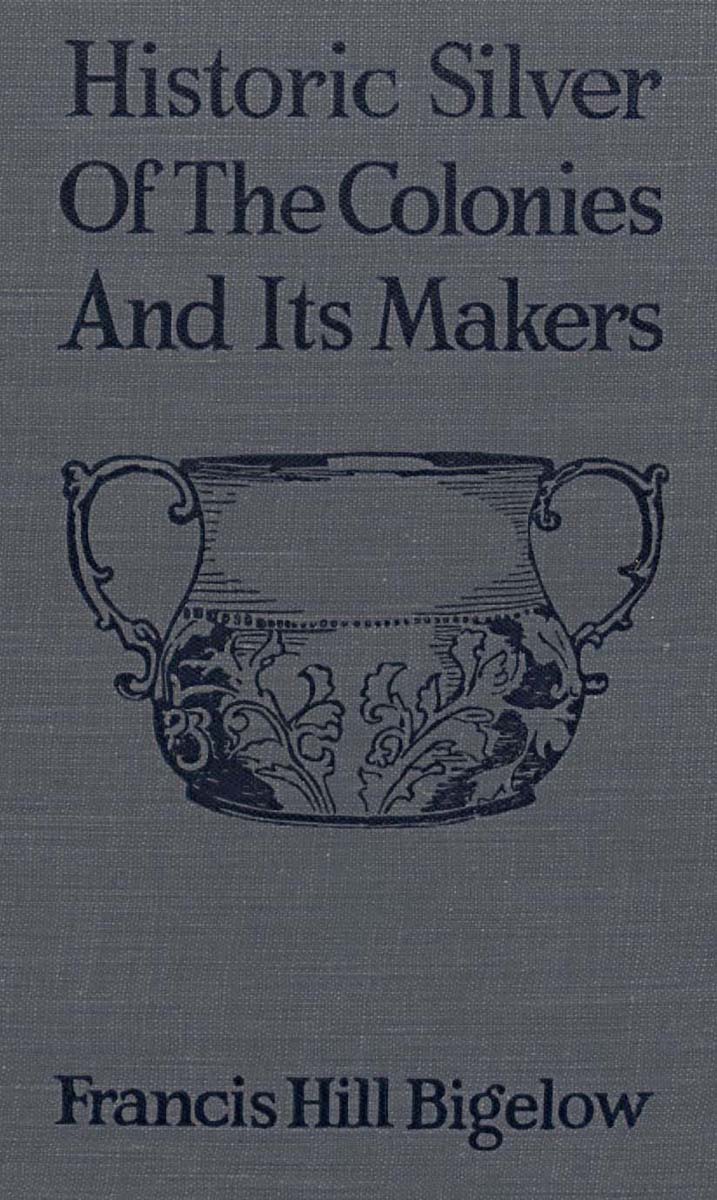





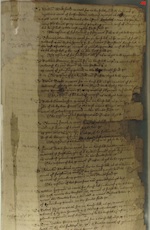
.gif)
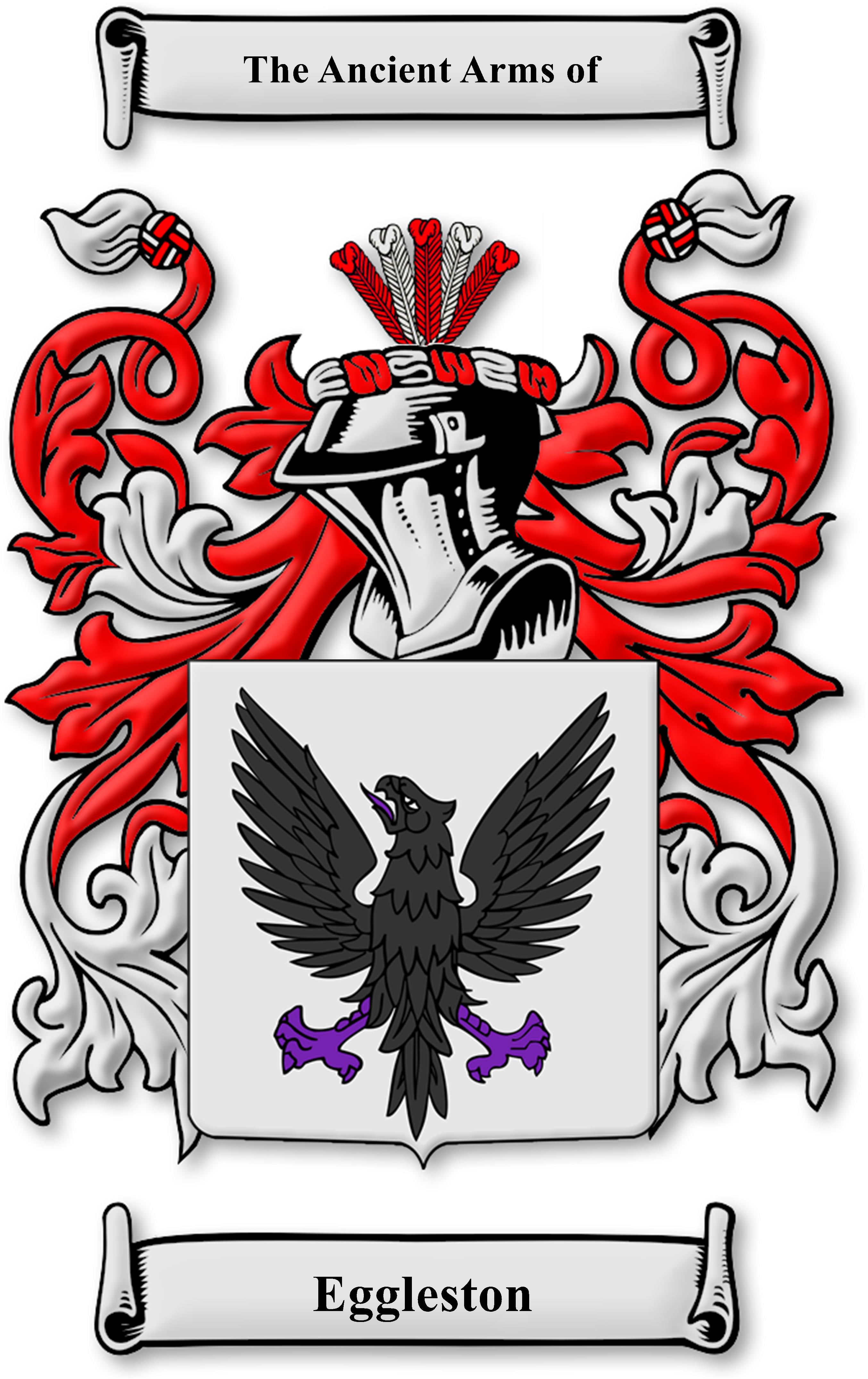



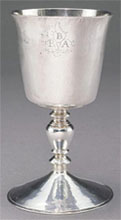
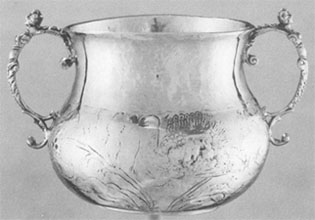
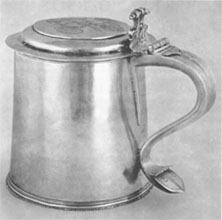

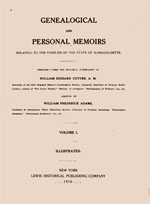


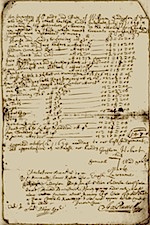
.gif)
.gif)


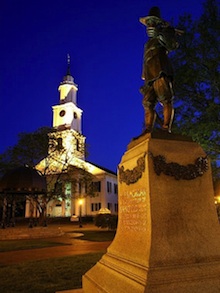

.gif)



.gif)





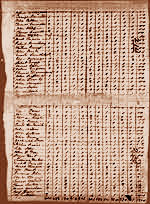
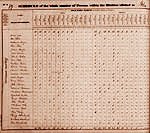
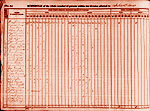
.gif)

